
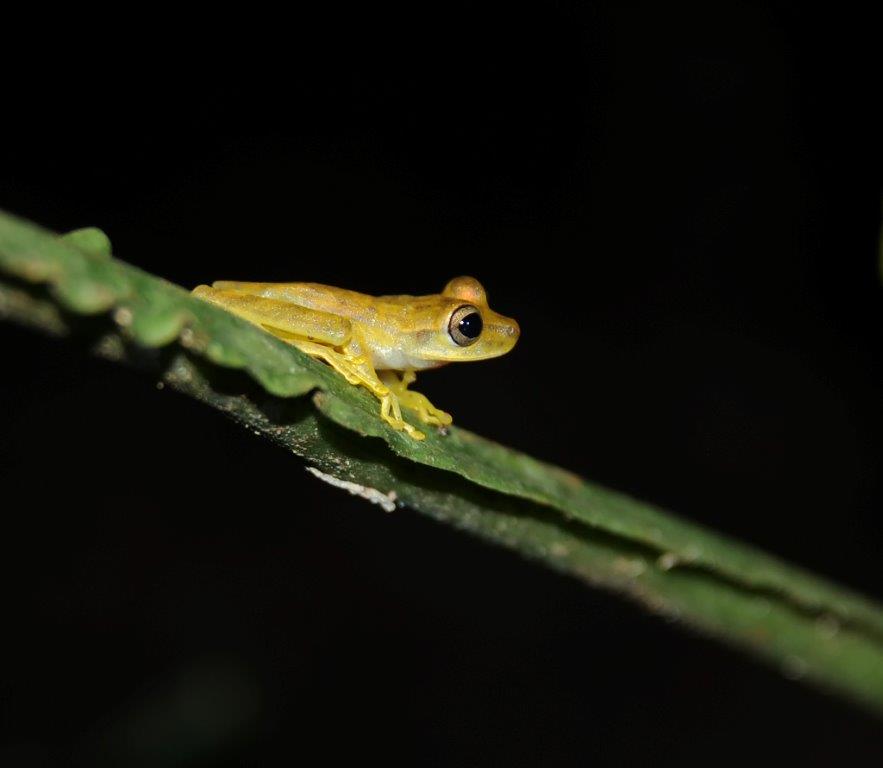
Peru: Inca Ruins and Jungle Exploration
story and photos by Tab Hauser (posted 9/13)
This story and photos may not be used without permission.
Contact tab@tabhauser.com for inquires


Classic Machu Picchu Tree Frog On Night Jungle Walk
(The following write up is on our trip to Peru. It is a hybrid story of sorts. By that I mean it is longer and gives more details than any travel article you may read in a magazine that is heavily edited. On the other hand it gives less details than a full guide book where perhaps too much is listed. This story discusses the amazing sites we saw along with some of the food we ate so read on and enjoy the ride. Details on the places we stayed at are in the "If You Go" section)
Peru has been on our list of countries to visit for many years due to its diversity of things that interest us. These interests include seeing the ruins of a past civilization culminating in a visit to Machu Picchu after touring the sacred valley. Equally as important was our visit to a jungle that was part of the Amazon Basin. We did this part by staying at a jungle lodge for two nights and then going deeper in and staying at a research center for another two nights. After visiting our two main destinations we added in some sand boarding and dune buggy rides in one of the driest deserts and even did a fly over of the Nazca lines that were created between 500BC and 500AD. Our trip ended with a full day in the busy capital of Lima. Our family trip took two weeks but if you are pressed for time you can do it in two weekends and the week in between making it a total of nine days. We arranged for our adventure working with small Peruvian company that gave us good service out of Cusco and we can help you do a similar trip.
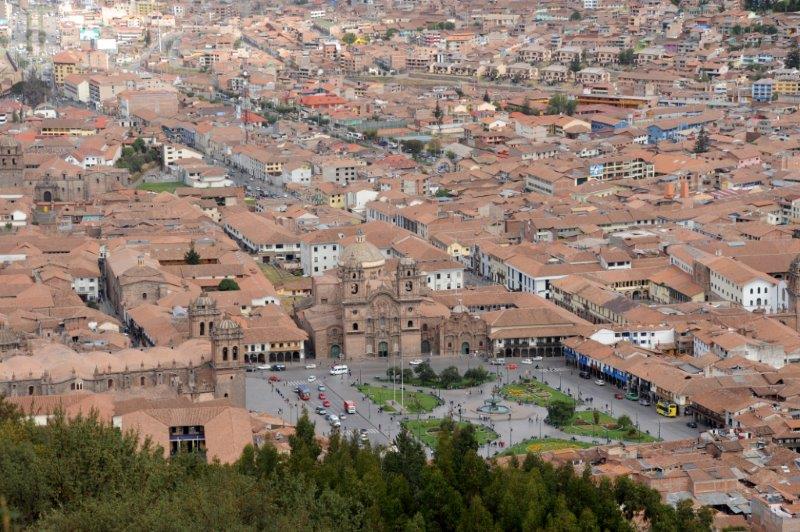
Cusco View From Saqsaywaman
Chapter One: To Cusco and The Sacred Valley
Our visit to Peru started with our arrival at night into the airport in Lima. Here we arranged to stay at the Ramada located directly across the street from the terminal due to our early morning flight to Cusco. The hotel was very comfortable and perfect for what we needed. We also liked that our included breakfast was served early. In Cusco we were picked up by our guide and driver who advised about our day before dropping us off at the Rumi Punku Hotel for a couple of hours of "slow moving". Cusco is at 11,000 feet (3800 meters) and due to the altitude and it was important to drink a lot of water, have lunch and move about slowly before our 1:30 pick up for a tour of the ruins near Cusco and brief walking tour of the center of town.


Cathedral In Cusco Town Square s One of The Many Narrow Streets
.jpg)
.jpg)
.jpg)
While Most People In The Streets Dressed Normal, There Were A Few In Regional Clothes. (Girls After School Sharing a Secret)
Cusco is a city located in a bowl surrounded by pretty mountains that was declared a UNESCO site in 1983. There are about half a million people living there. Our tours first stop was the ruins of Saqsaywaman which started construction around the mid 14th century. ( The name is almost pronounced as "sexy woman"). This place up above the city was an important fortress and religious sight made of well placed and smooth boulders. These boulders came from quarries as far as twenty miles away. The hand cut stone walls that have withstood the test of time and earthquakes by the way they were placed. Unfortunately Saqsaywaman was had one the bloodiest battles in 1536 between the Inca and Spanish forces. After the Inca were defeated much of this complex was taken apart and used as a quarry to build the churches in the city below. What you see on the site are many of these walls and foundations. This area also has large terraces used for planting. During our visit there was a herd of lamas in the central area eating grass. We finished our visit to this area by walking up the steps to the top for the view of the city below and mountains in the distance. The view was breath taking in more ways than one as we were breathing harder at 11,000 feet.
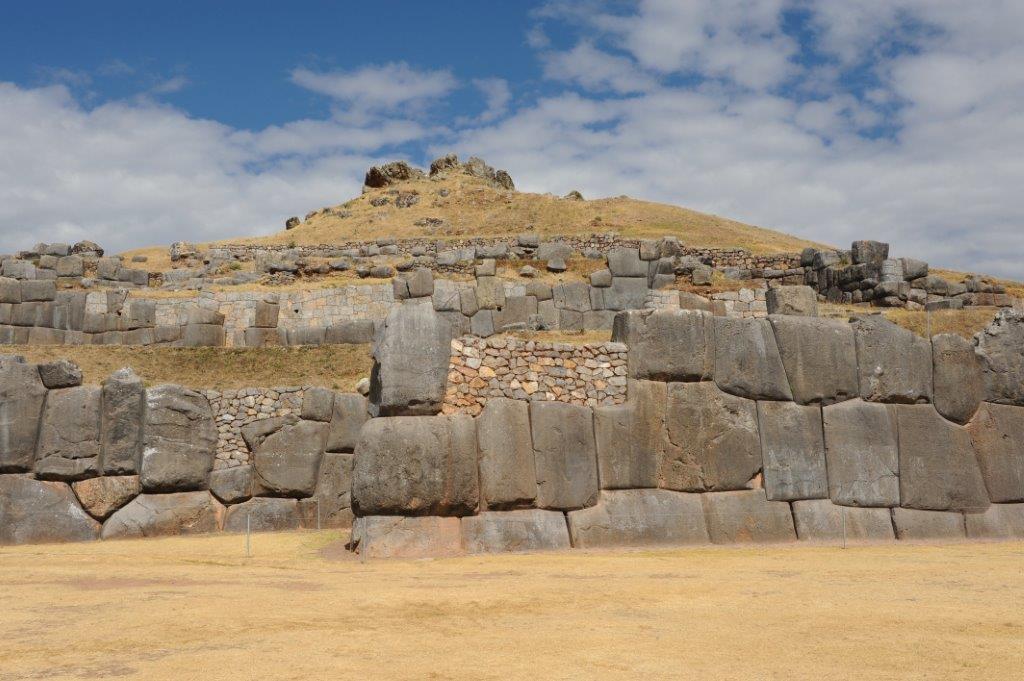
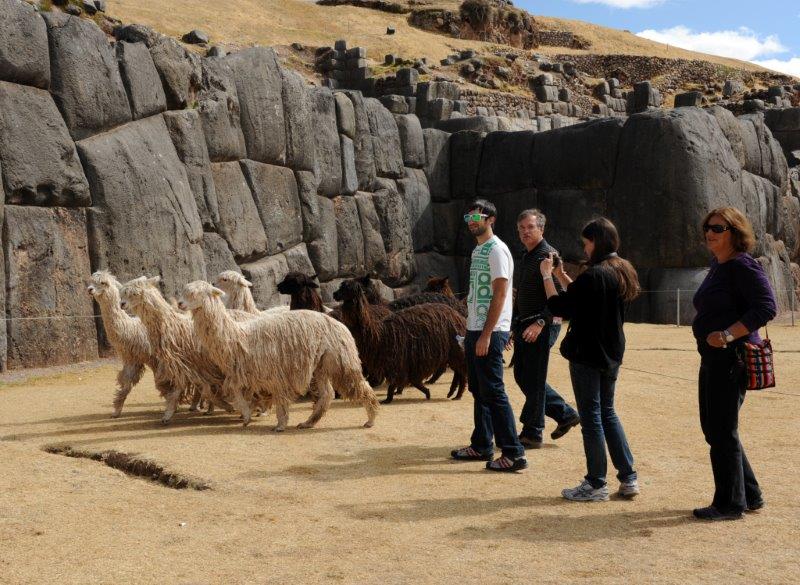

Saqsaywaman
With my wife Maureen into knitting we did a little research and requested our guide to take us to a place to buy baby alpaca yarn. The reason for this is because baby alpaca yarn is extremely soft to the touch and will make an amazing sweater. After our stop we drove a few minutes to another nearby site which was cave like and was known for its religious and sacrificial offerings. From there we headed down hill to Cusco for a brief city tour which covered the two churches at the Plaza de Armas. Both the Cathedral of Santo Domingo built in 1539 and Iglesia de la Compañía de Jesus (Church of the Society of Jesus) built in 1576 were built on the foundations of an Incan palace. Part of the walls and a few rooms in the church were from the original Inca structure. The Spanish who conquered the region used the stones from ruins of Saqsaywaman to build the basilica attached to Santo Domingo starting from 1560 and taking over 100 years to complete. The basilica was highlighted with an ornate alter made of silver weighing over 4000 pounds. We parted from our guide several blocks from our hotel so we can wander around on our own and look at a few shops. After a long day out we splurged on the dinner by going to the upscale Map Cafe in the Museum of Pre-Columbian Art. Here in the museum court yard under low lights and candles we were served a three course gourmet Peruvian meal.
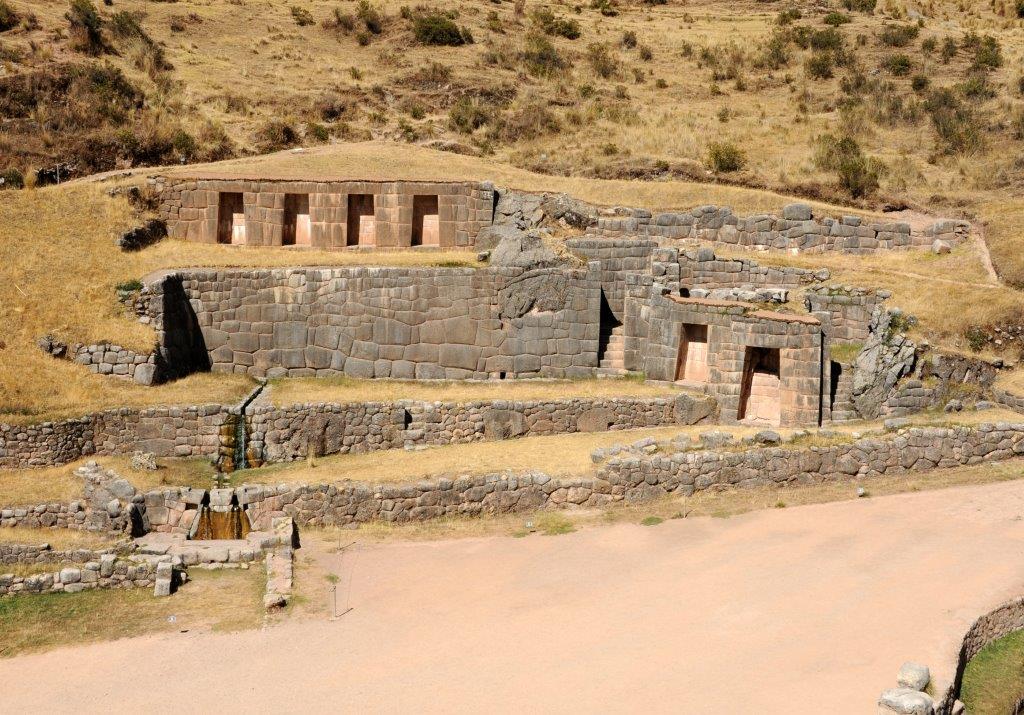

The next morning we were picked up at 8:30. Before our tour started we had to drop off the bulk of our luggage at the Ramada in town where we would return in three nights. The reason for this was that our tour today was going to end in Ollantaytambo where we would board the 4:30 train to Machu Picchu. People going there can only take back packs and not large luggage. With luggage dropped off and we were on the way to the Sacred Valley. Our first stop was at the ruins of Tambomachay at 12, 352 feet (3765 meters). This place is also known as the "Baths of the Inca . Here at the end of a very pleasant walk we viewed a structure built of large stones into a mound. This structure had a narrow canal of water coming out of it creating a fountain. This was then split into another two fountains We found this sight very tranquil.
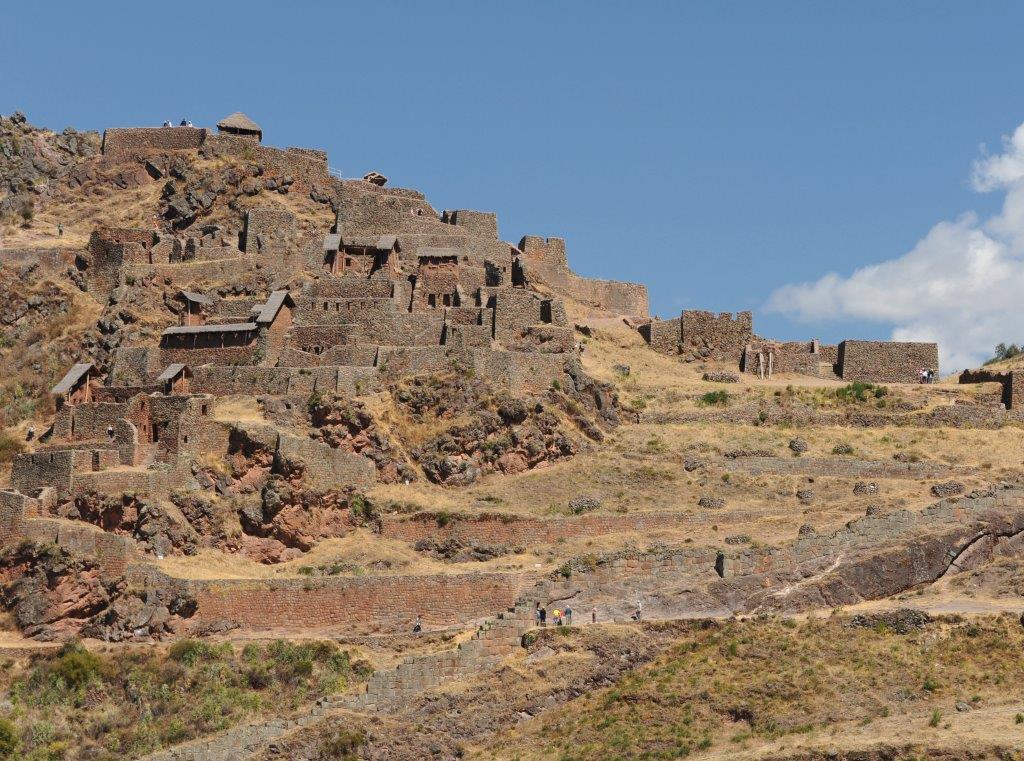
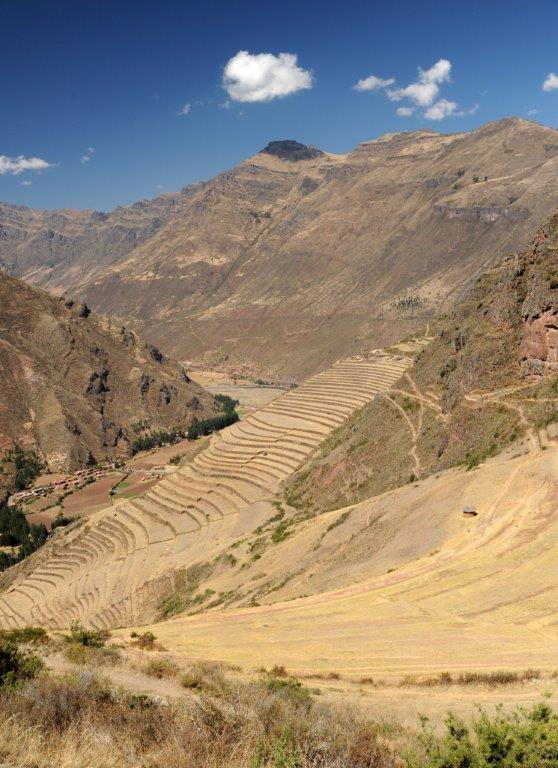
Pisaq
From Tambomachay we drove to the Archaeological Park of Pisaq high on a mountain overlooking the town Pisaq. From the parking lot we walked up to view the restored terraces. From here it was a hike up to the ruins on a dome where we observed the walls and walked through the ruins while admiring the view. Our guide pointed the ridge behind us where farmers worked a small plot of land at over 12000 feet getting supplies only via a foot path to town below..

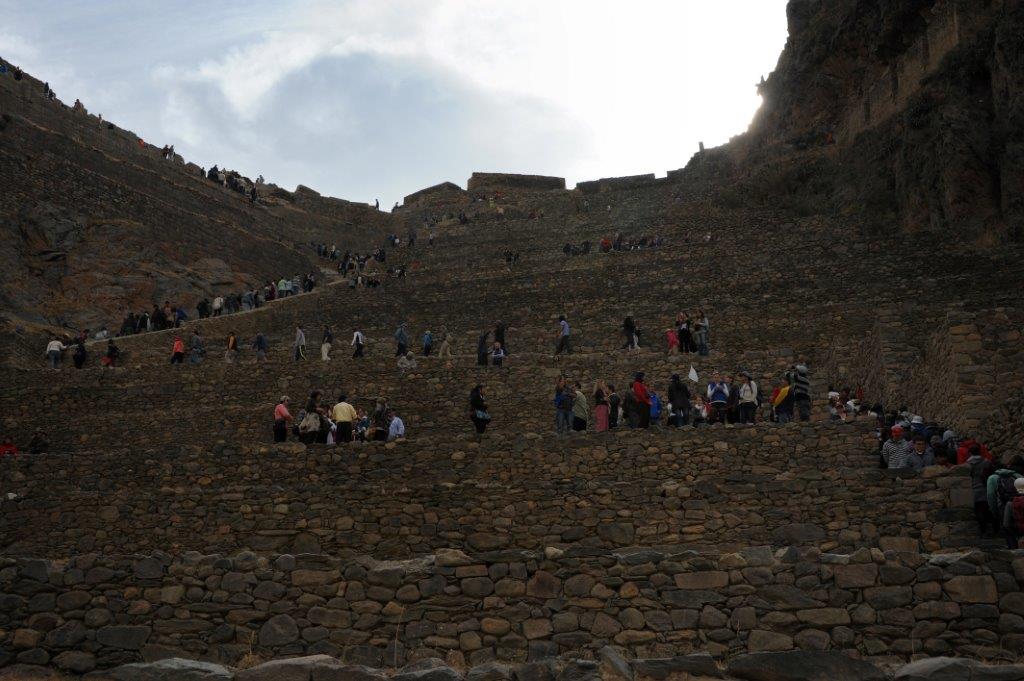
Guinea Pig "Take Out" Ollantaytambo Looking Up
After leaving here we continued driving through the pretty country side. At one
point we went through a small village that had a few stalls selling roasted
guinea pig on a stick to go. Takeout food in these parts is different than what
we are accustomed to back at home. (later in Lima we tried guinea pig for
dinner). Our final destination of the day and was Ollantaytambo.
Ollantaytambo is considered to be one of the most important Inca sites. Our
guide told us that while Machu Picchu gets worldwide recognition, it is was
Ollantaytambo's strategic location that helped allow the Inca to rule because of
their ability to control traffic, commerce and water resources that met from two
valleys here. He also stated that the Inca's understood micro climates and what
planted best at the different altitudes here. It seems no one was ever thirsty
or hungry here.
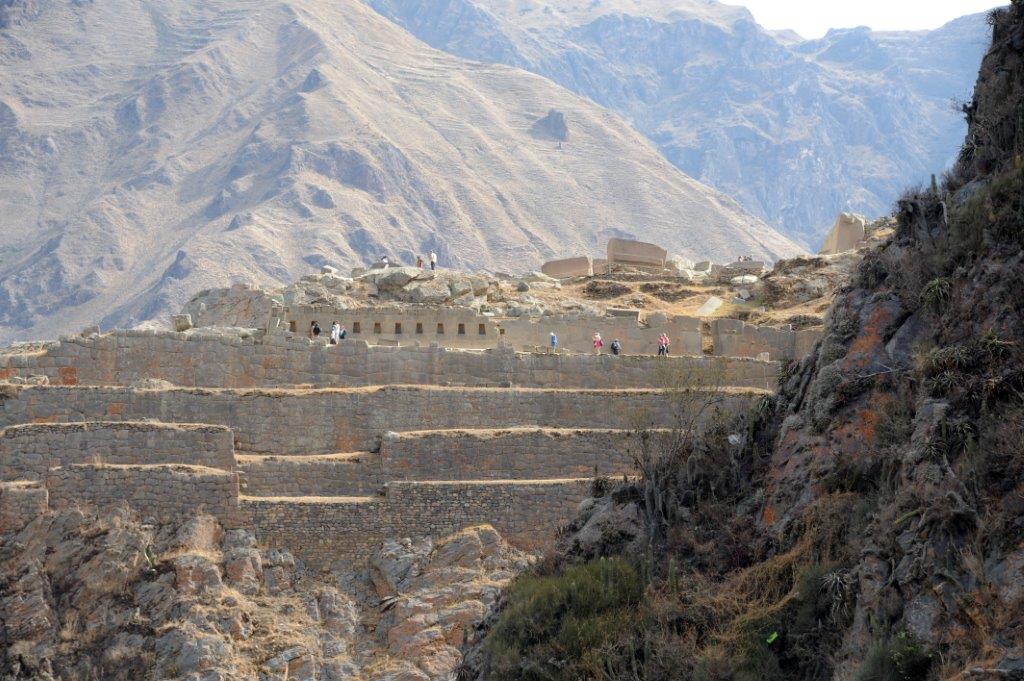
.jpg)
.jpg)
Views of Ollantaytambo
Climbing up to the top of the ruins requires one to be in good shape as the center stairs are steep. Our guide bypassed the tour groups and those steps taking us to a less crowded and easier way up via the right side. During our hike up we viewed the perfect terraces that the Inca were known for building to our left while seeing the imposing ruins (and natural rock shaped face) on the opposite mountain. On the top of Ollantaytambo we saw the granite boulders that were quarried high on a mountain across the river. Here was a 50 ton square piece of granite that was the center piece of what was a temple. We learned that this place was conquered and destroyed by the Inca emperor in the mid 15th century who set about rebuilding and fortify the area. From the top we went down the middle stairs and walked some of the streets in the village. Here our guide pointed out how the water channels were cut into the streets besides the homes and stores set in rows. (He said the water is used for laundry but not drinking.) Our stroll around the village had us crisscross a few of the narrow pedestrian cobble stone streets admiring the Inca walls holding up the new structures where people lived or had stores. Later we learned that Ollantaytambo has some of the oldest continually lived in homes in South America After our walking tour we caught the 4:30 train to Agua Calientes for our scenic ride to Machu Picchu.
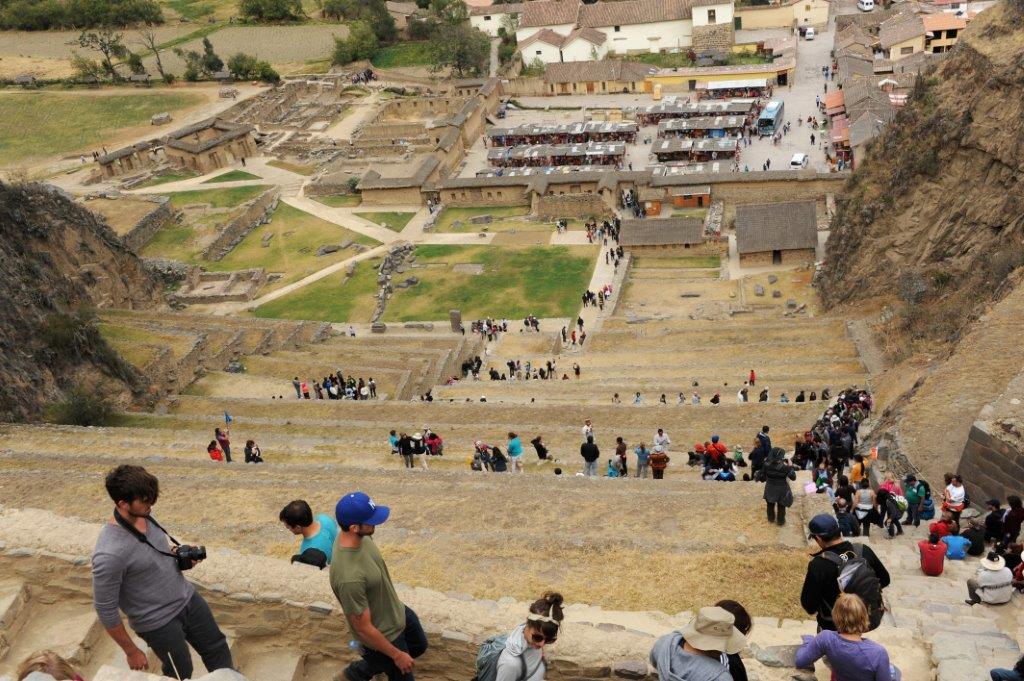
.jpg)
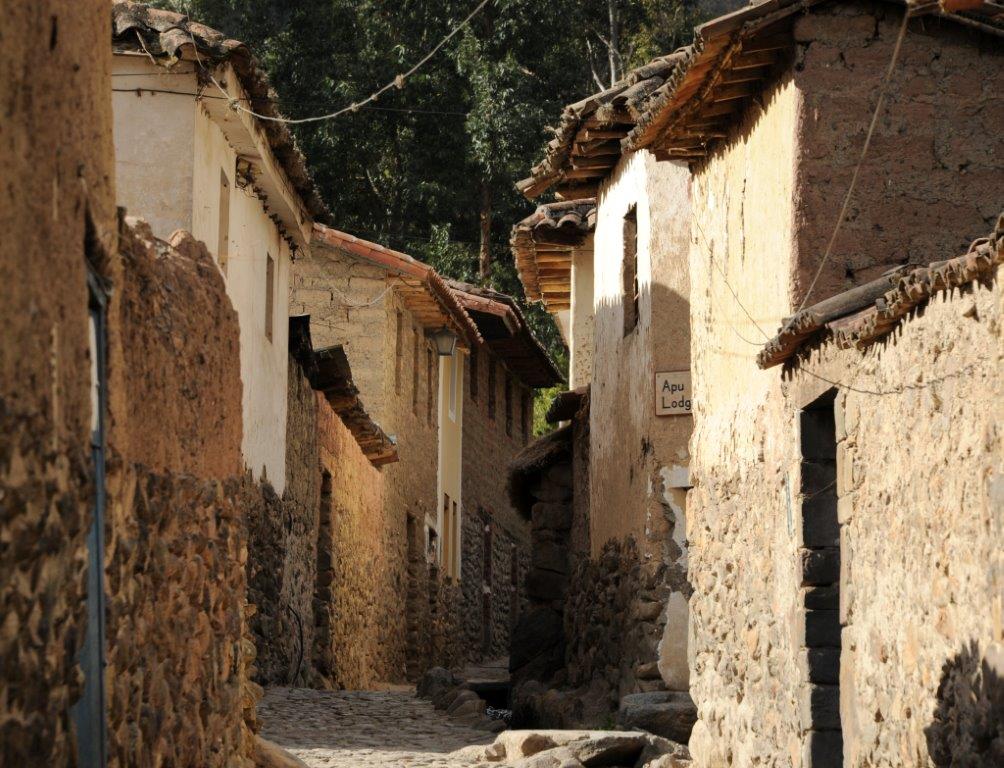
Ollantaytambo Looking Down Old Streets of Ollantaytambo
Chapter Two: Magnificent Machu Picchu
Agua Calientes is the only town accessible to Machu Picchu. The train track
where passengers disembark is basically the "main street" with shops and
restaurants on both sides. While the Sumaq hotel provided a staff member with
a cart to move our backpacks for us to the hotel, we followed our guides advice
and carried them down the hill ten minutes to save time. There are no cars or
taxis in town. Before checking in our guide briefed us, checked our admission
and bus tickets and told us we would need to bring our passports or copies of
passports to match the name to tickets. He also recommended he pick us up at
6:10 AM to tour the park before the crowds came. After a very good dinner at
the hotel (which was included in the room rate) we went to bed early. We
thought the Sumaq was a top hotel.
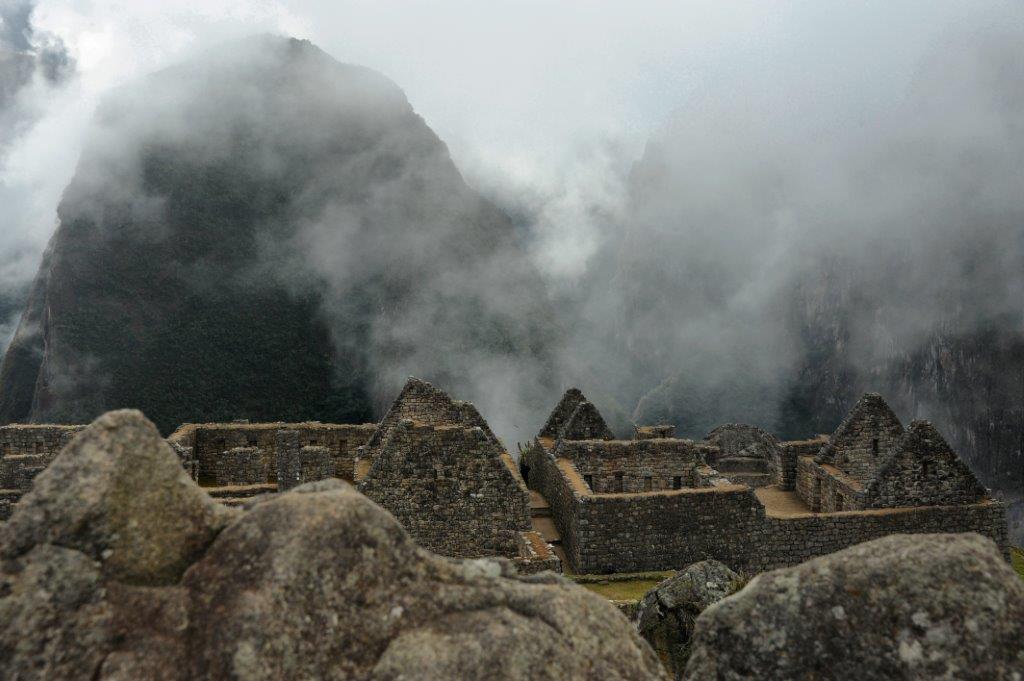

Machu Picchu Shrouded in Morning Clouds
At 6:20AM the next morning there was a five minute wait for the buses to Machu Picchu which come one behind the other and leave once full. We were concerned as there was a low cloud cover and it was cool outside. The bus trip to the ruins took about 20 minutes and climbs very steeply on switch backs to 7972 feet (2430 meters). Once you get on top decide what you really want to carry around for the day and check in the rest just passed the entrance. (You can always come back and pick up or drop off a jacket) If you are not on a guided tour you can hire a guide at the entrance. Also note that there is only one bathroom before the entrance. Once passed the entrance there is a rubber stamp that people use to stamp their passports as a momentum to them being at Machu Picchu.
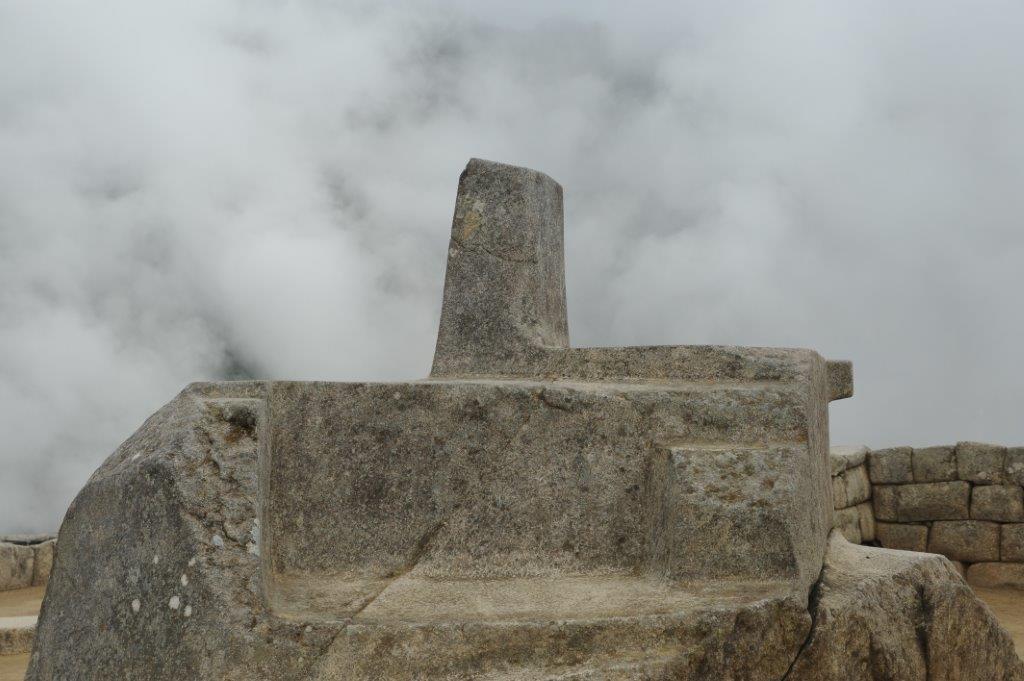
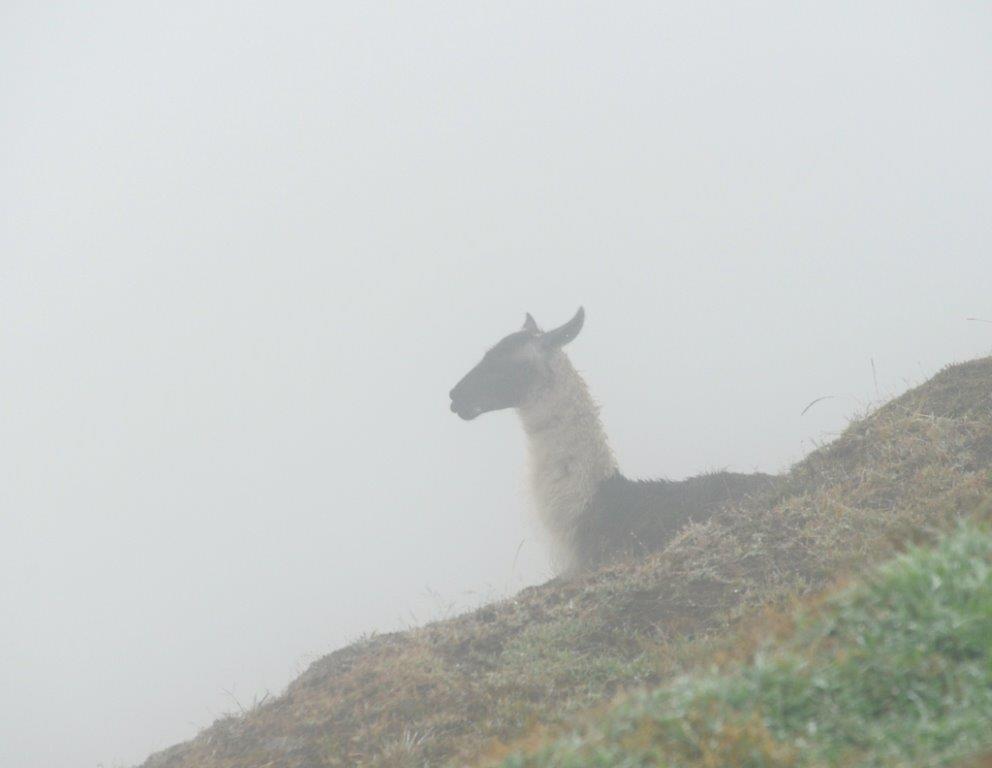
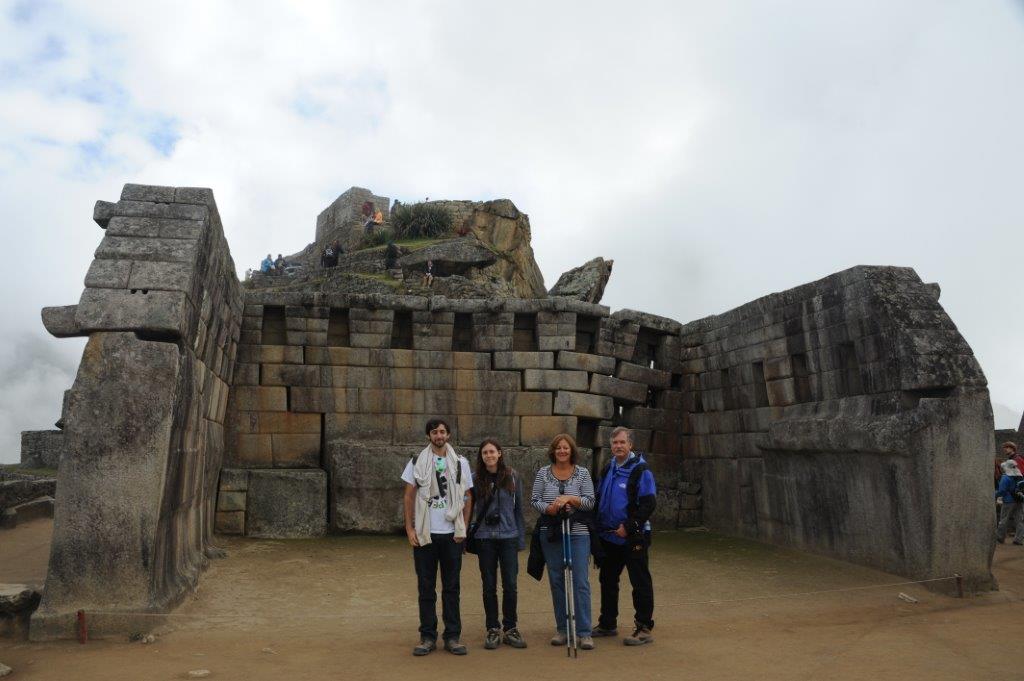
(Left to Right) Solar Clock Cut at 13 Degrees, Lama In Clouds, Hauser Family
Most people tour this site in a clock wise direction. This means taking a series of switch backs and steps for several minutes that may leave a few people a little winded due to altitude. Once this part of the trail is complete you see have an amazing view and have one of those "wow" moments. Suppress your urge to take a million photos here and continue two minutes up and to the left for a better view. With Wayna Picchu looming in the back ground it is indeed a sight to behold. We all stood on a ledge and waited for some of the clouds to lift watching as the ruins peaked through.
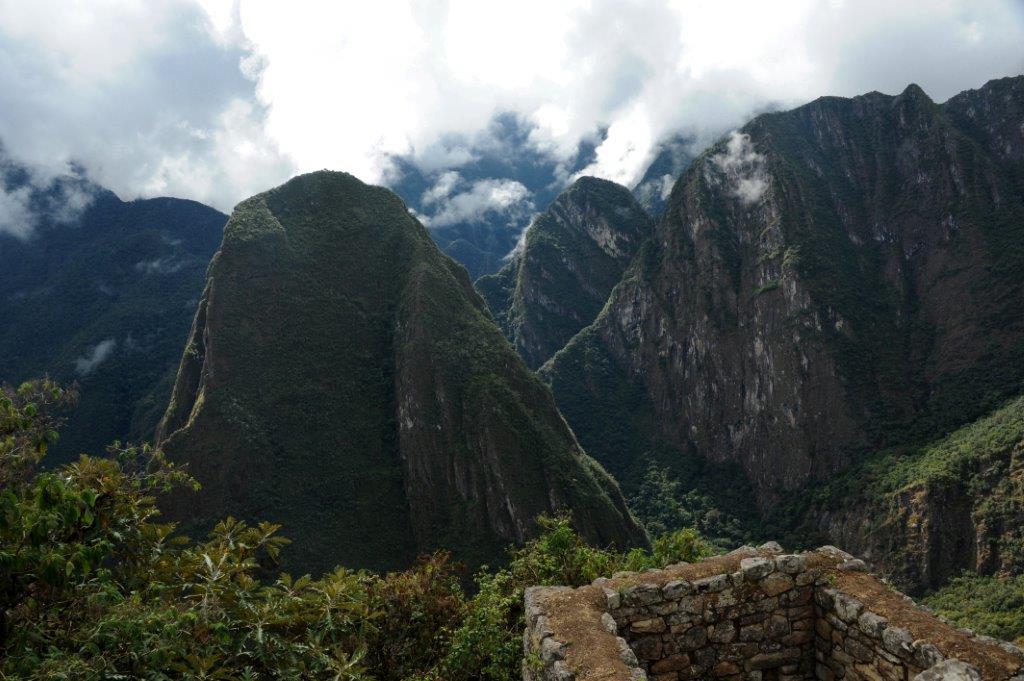
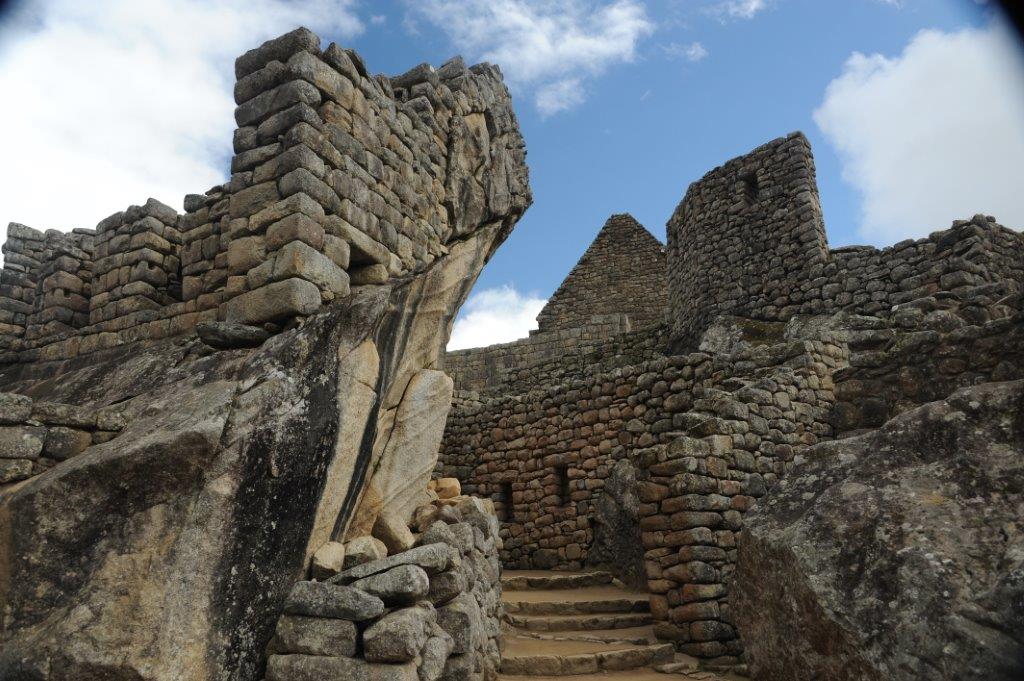
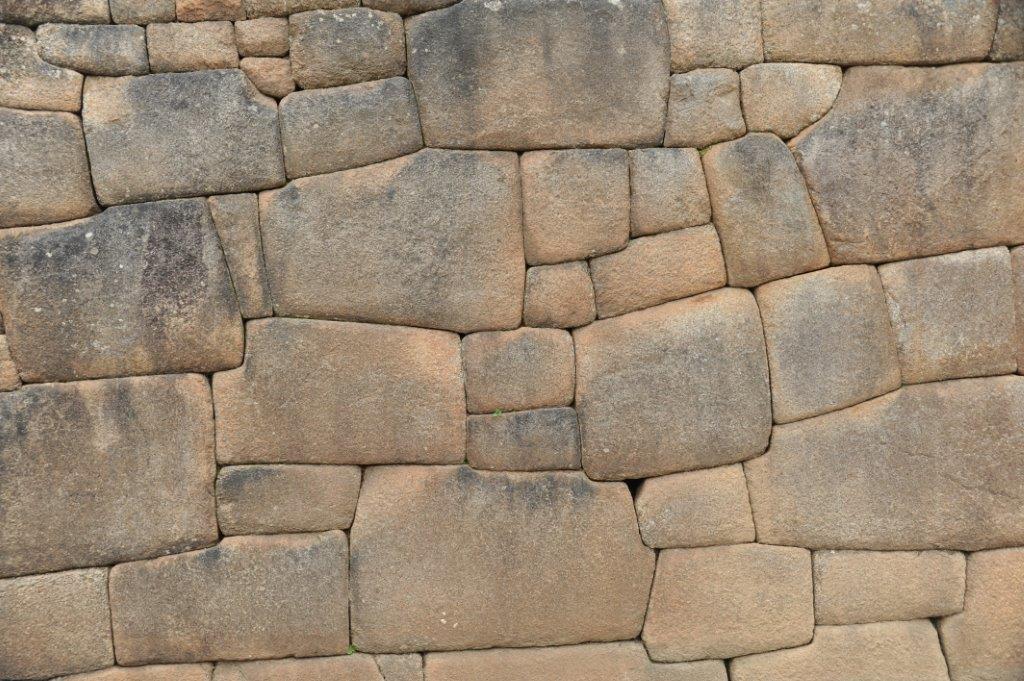
Left To Right: Machu Picchu Mountain View, Structures Near Center, Hand Cut Stone Wall Withstands Test Of Time
Machu Picchu is believed to have been a palace for the Inca emperor in the mid 1400's and abandoned about 100 years later. We learned that this place was a special sacred site based on its location around the nearby majestic mountains. The site has two temples devoted to the sun. It also has enough terraces for planting and springs to allow people to prosper. The area is protected by its height and by narrow paths along with a protected bridge. We learned than the Spanish never knew of the site and as a result never destroyed the temples or plundered it. While Hiram Bingham is credited with its modern discovery there are records of a German business man that may have plundered the area in 1867 but did not say anything about the site to as to keep it to himself. Locals always knew about it but did not think much of the place and went about their business. The guide stated it was Hiram Bingham that understood the importance of the place and shared it with the world in an archaeological manner by properly mapping and excavating it under the sponsorship of National Geographic. By 1976 thirty percent of Machu Picchu was restored. The place was given UNESCO status in 1983. In 2008 it was placed in the top 100 Most Endangered Sites.

Our tour took two and half hours in which we were pointed out different sections. These included the storage area, terraces, temples and homes. All about the place were perfectly built walls made of large smooth hand cut stones. On our tour we walked to two temples. One, temple, the Intihuatana had a solar clock carved into a huge stone. The top part was shaved off on the precise degree that the Earth rotates on its axis. Besides the different structures we saw how water was channeled through the area via springs. At the end of our tour we were given some tips to explore this mountain top marvel on our own. With the clouds gone we decided to pick a terrace and just take it all in watching the place get busier with tours. Lunch was the buffet restaurant adjacent to the entrance. While this was not cheap ($40) it was good and plentiful. We did enjoy the alpaca tenderloin with local elderberry sauce, fish and Peruvian Salads. From lunch we re-entered Machu Picchu and took the switch backs past the guard house heading for the Inca Bridge. This was a nice 45 minute walk along a path made on the side of the mountain. People from the tour buses were not venturing to this area probably due to lack of time or energy from walking all about the ruins so it was a very peaceful here. Just short of the bridge we saw how the trail went from being cut into the mountain to being built up from ground by stones. It is hard to imagine how they built such a tall path with stones layered up. The "bridge" we saw was nothing more than a plank of wood separating a large opening in the stone path on the side of the mountain. For security the Inca's could simply pull back the wood making it impossible to cross and very easy to defend.
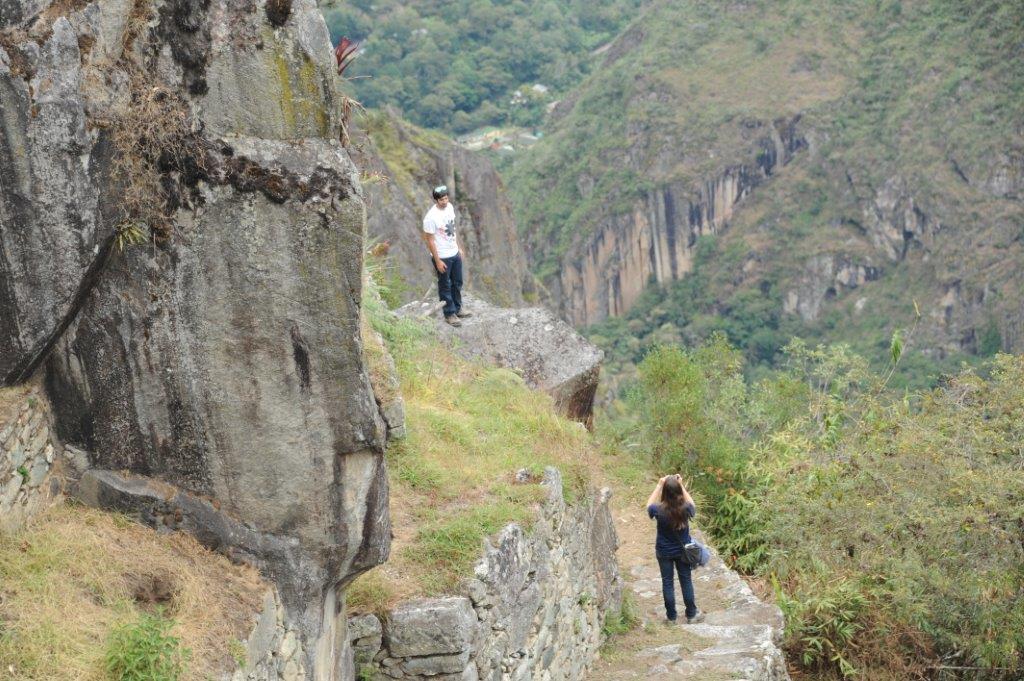
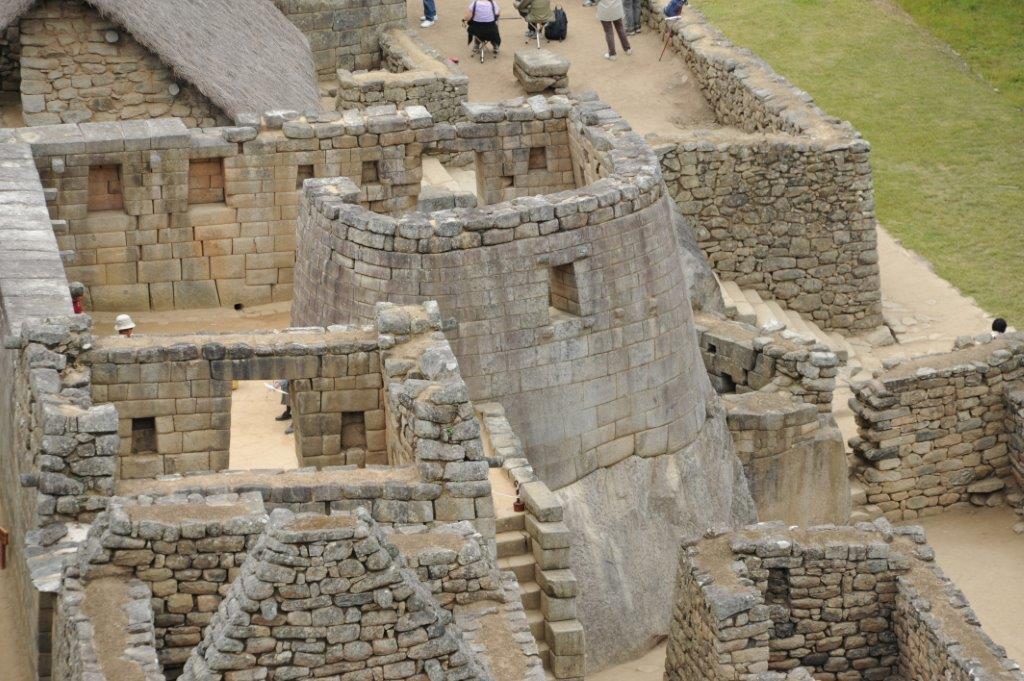
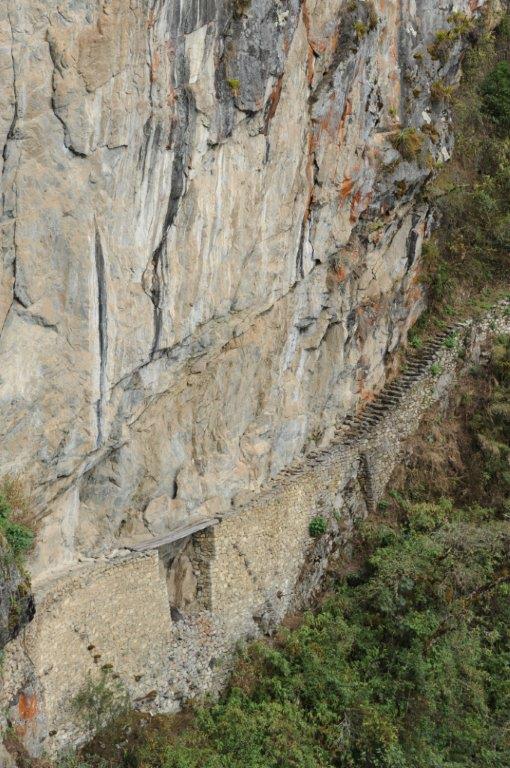
Left To Right: A Quiet (and Steep) Corner of Machu Picchu, Sun Temple, The Well Protected Inca Bridge
On our second day in Machu Picchu we arrived at 9:30. Three of us were going to use our 10AM reservation to climb the difficult trail up to Wayna Picchu. Wayna Picchu is the dome shaped mountain that overlooks Machu Picchu giving the place a more dramatic look. It requires 1200 foot (260 Meters) climb on steep steps until you reach its peak at 8920 feet (2720 meters) Only 400 people are allowed on it per day with an advanced appointment stamped on your admission ticket. It took us 55 minutes with several stops to catch my breath before we reached the top. Once there we enjoyed not just the view of Machu Picchu but lingered on the boulders on top that looked out to the taller steeper mountains that surround this area. While we were on Wayna Picchu Maureen hiked to the Sun Gate. This scenic walk took her nearly three nearly three hours round trip and offered wonderful views of the area. After lunch at the cafe at the entrance we went back into the site for another couple of hours as we had a late train and decided it was better to sit, rest and even nap on a terrace overlooking Machu Picchu than sit in a hotel lobby. My advice if you visit here would be to take the later afternoon train in and stay two nights. Take the tour when you get hear and linger a bit. I would leave mid afternoon on after the second night after visiting the Sun Gate or doing the climb. Keep in mind the best time for Machu Picchu is after 3:30PM when the crowds really thin out. If you are short on time at least stay one night and take the evening train back on the second day. Transferring back to Cusco on the Inca Rail and then car takes about four hours.
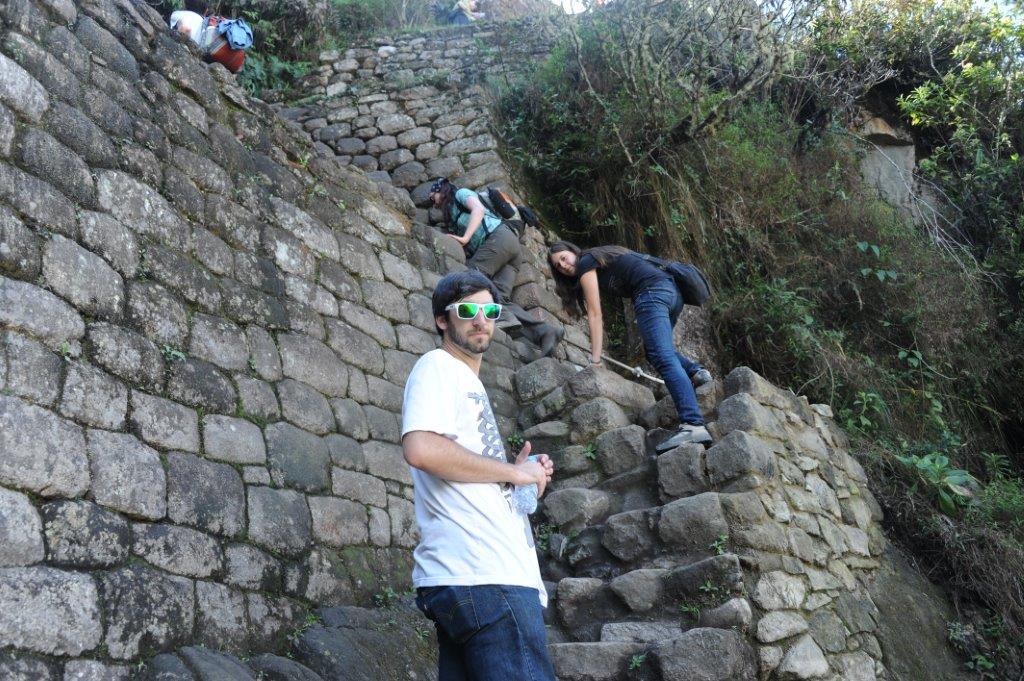
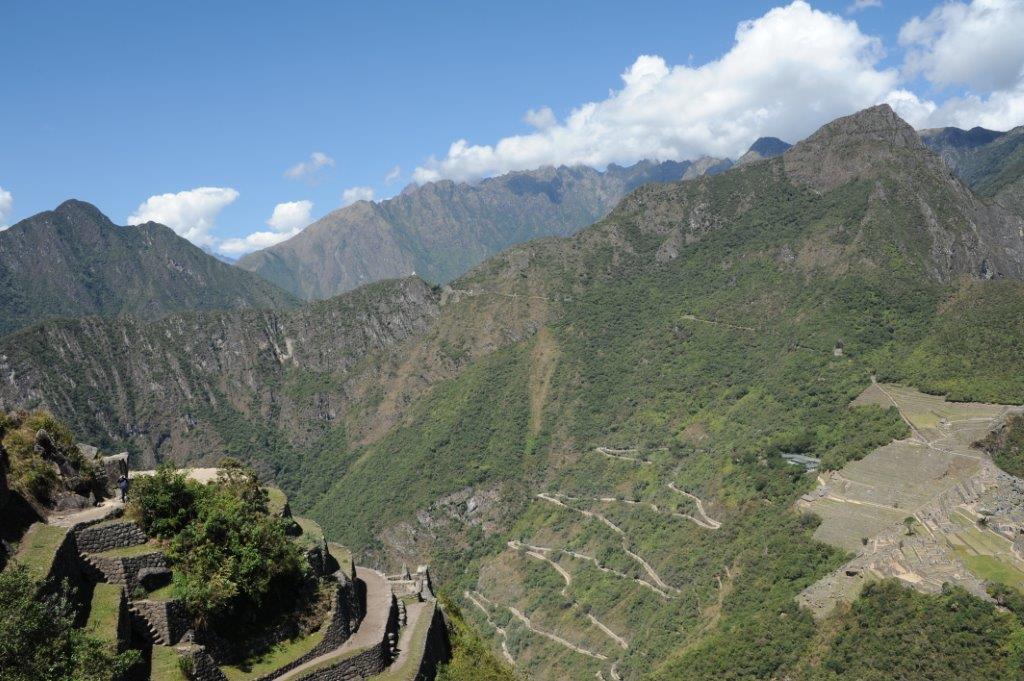
Climbing Wayna Picchu and View With Switch Backs Buses Take
To The Jungle:
After spending the night in Cusco we headed to airport for the morning flight to Puerto Maldonado which is the jump off point for the jungle in this region. At the airport we were picked up by our guide Fernando of Rainforest Expeditions and taken to the office to sign in and reduce our luggage to what we needed using their duffle bags. Our luggage with our non-jungle clothes securely stayed in their office. From the office it was a short ride to the river where we boarded a narrow long boat and headed to the Refugio Amazonas. (these boats are not set up for large pieces of luggage) On board the guides pointed out different wild life and handed out a delicious rice dish lunch wrapped in banana leafs or what I call an eco friendly sandwich bag.

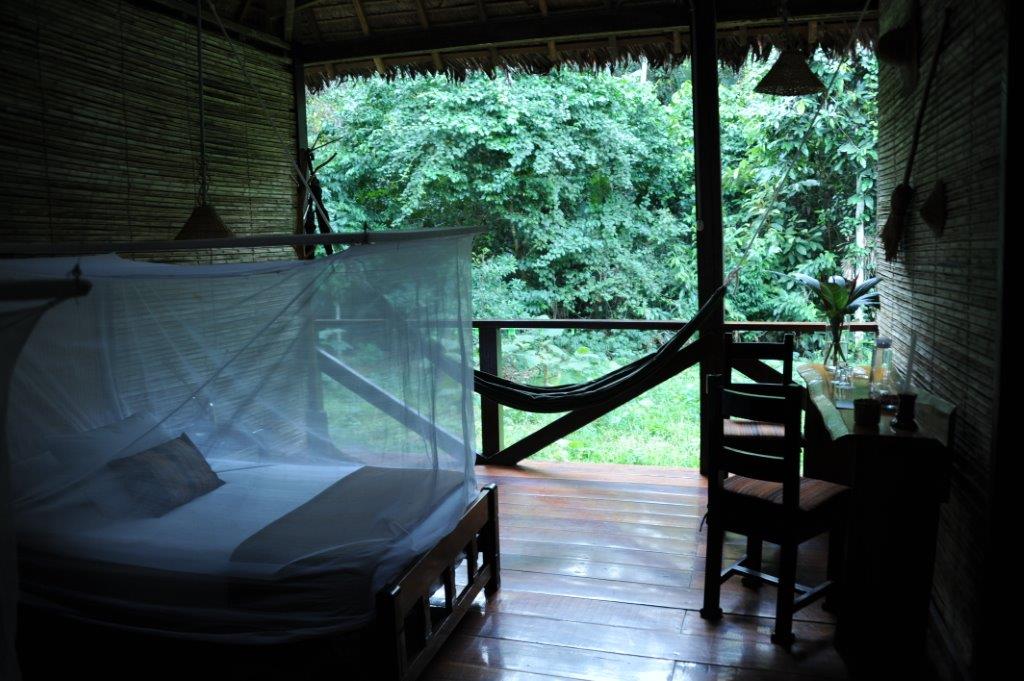

Left To Right: Boat Ride To Lodge, Open Air Room, Monkey Near By On Jungle Walk
At the lodge we were given an overview on how power and internet would be on from five to ten PM each evening and then 730 AM for about 90 minutes. We were then shown to our unique rooms with one wall open to the jungle. Beds were covered in screen material to keep the bugs out. Our section of rooms had electricity and for charging along with lights and internet when the power was on. The building opposite our section was not renovated with power so request the updated rooms when you make reservations. Rooms here had thin bamboo walls with open ceilings. While you had privacy and your own bathroom, you can hear what goes on in the next room if your neighbors don't keep their conversation lower than normal. The rooms and shower were comfortable and did the job needed.
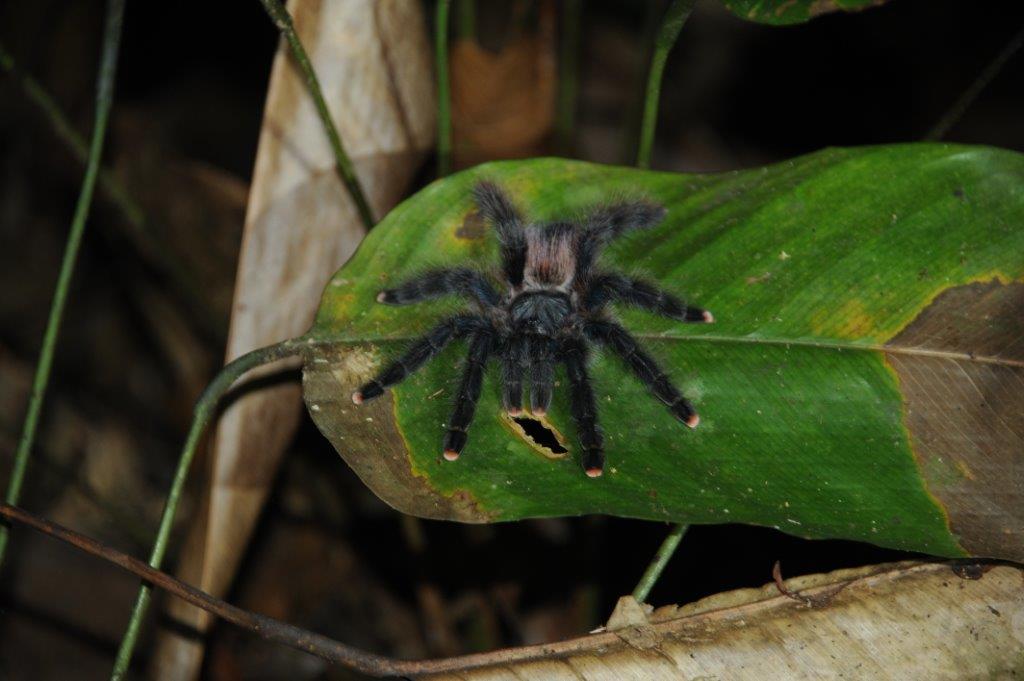
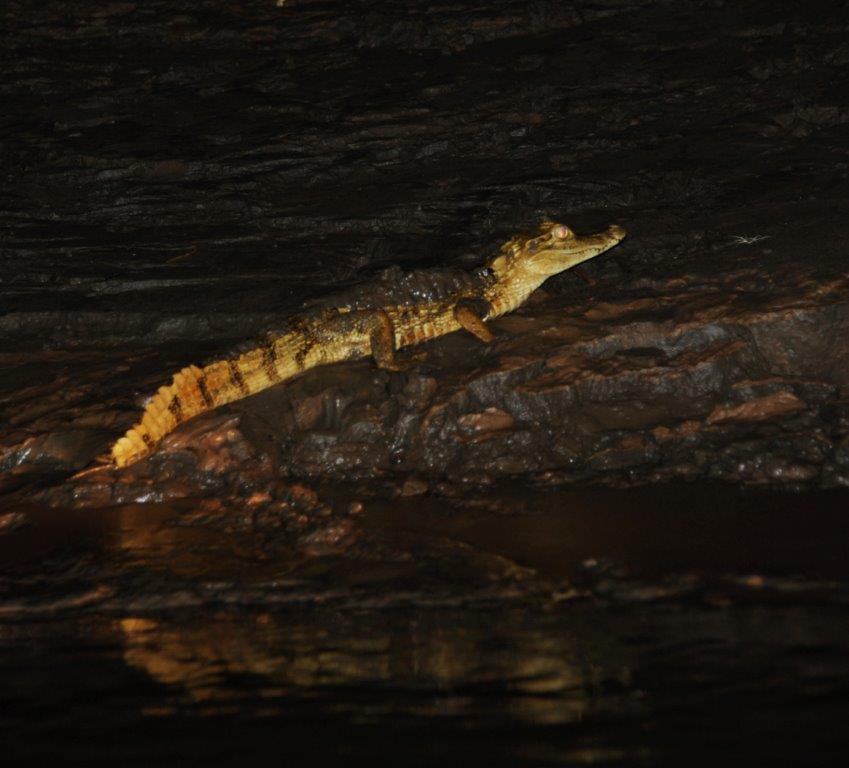

First Night At Lodge We Spotted a Tarantula and a Couple Of Caimans
Before dinner we were attended a lecture on caimans that live in the area and told that after dinner when it was dark there would be a search for them on the river using a spot light. On the night walk through the woods to the boat we saw a large tarantula on a leave just off the path. The caiman search had us view three small white caimans that were four to five feet long (about 1.5 meters). These were found only a few hundred yards from the lodge on the shore. On the way back to the lodge the captain turned off the engine and the guides turned off the light requesting absolute silence as we floated down river to hear only the sounds of the jungle.
Bedtime for us was 10PM but at midnight we had a little visitor in our room. Earlier that afternoon the manager stated that the animals do not wander into rooms but did warn us not to have any food out. The day before I forgot I put a single candy on the side of my back pack where the mesh is suppose to hold a water bottle. I was woken up by the loud crunching of plastic but did not see anything when I put on my flashlight. I lifted everything from the floor but heard the crunching of plastic again 30 minutes. Again I turned on the light and saw nothing. This time I dimmed my flashlight as to not scare the creature. Twenty minutes later I saw a six inch furry creature with a long tail quickly make its way to my backpack. This time I caught him in the act and realized my mistake. After shooing this cute little possum out of the room I tossed out the candy and put the backpack on the table. Lesson learned I would say.
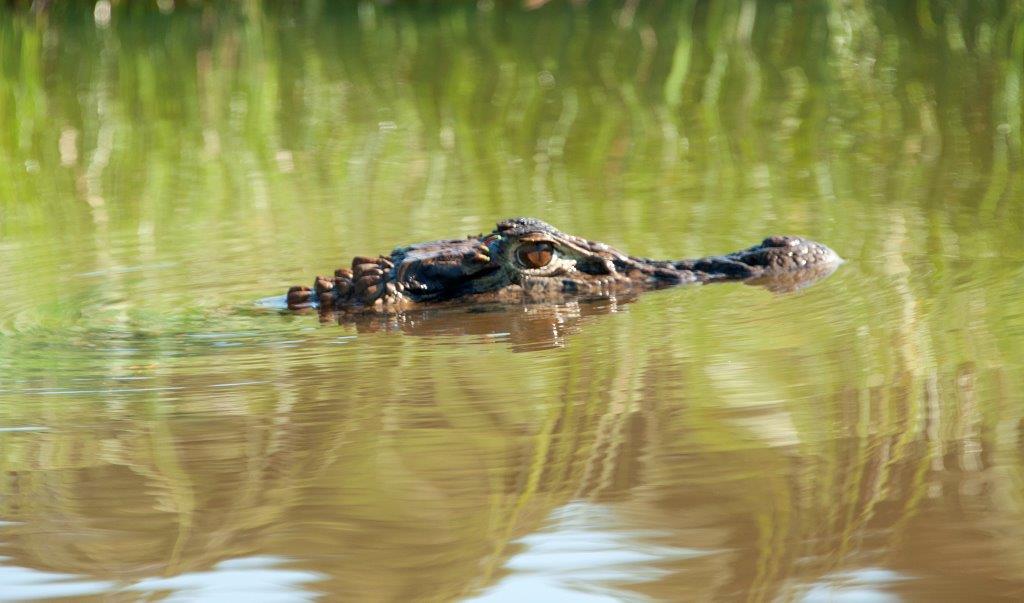
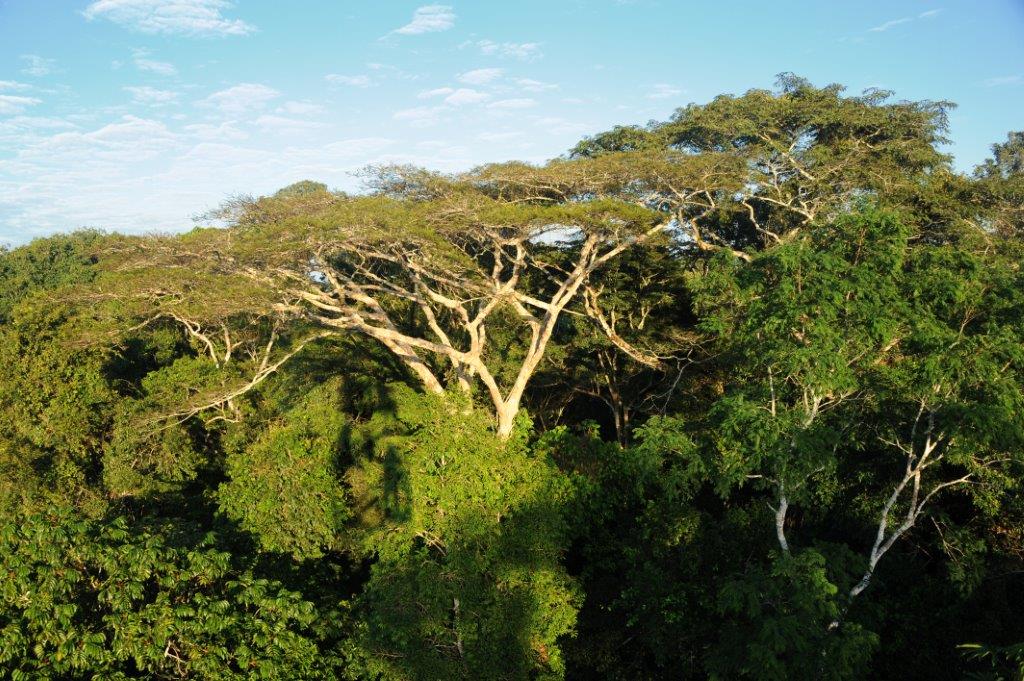
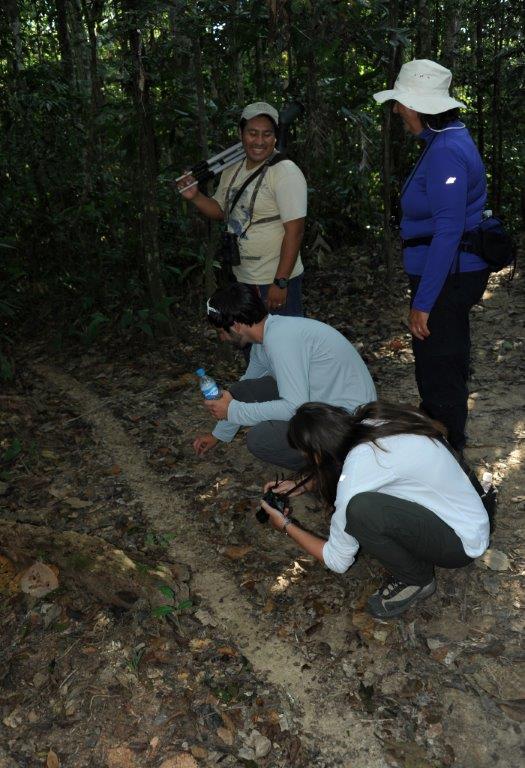
Left to Right: Caiman Popping Up,
View From Canopy Tower, Studying Leaf Cutting Ant On Their Narrow tTrail
At 6AM the next day we walked to a canopy tower to see the forest from a higher level. This tower required us to climb steps until we reached the platform 82 feet up (25 meters). Once on the tower we able to survey the jungle for many miles out but more important we were able to look down or eye level to things. Here we saw the beautiful trees tops as well as the large ferns below. We also spied on different birds with Fernando's spotter scope. After breakfast we walked to Oxbow Lake. On the way to the lake we passed over a trail of leaf cutting ants and under three monkeys. We were told the ants cut the leaves and bring them back to the colony to be turned into nutrients. We learned that these ants are one of the few creatures that has the ability to grow its own food. We also learned that colonies can have as many as 8 million ants! Once at the lake we boarded a wide canoe and viewed black caimans while Fernando paddled about. While on the lake we went up to a smooth bowed branch that had been in the water for some time where we viewed about a dozen small bats sleeping on the shady side of it. It was the first time I had seen bats a sleep outdoors rather than in caves or ceilings in abandoned structures.
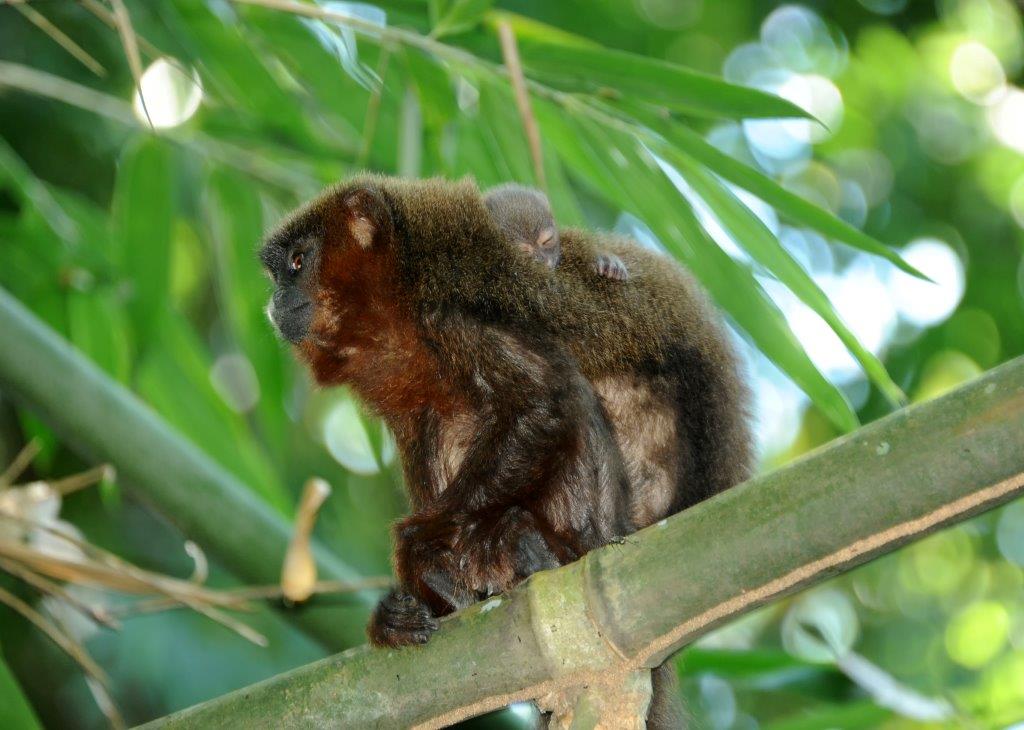

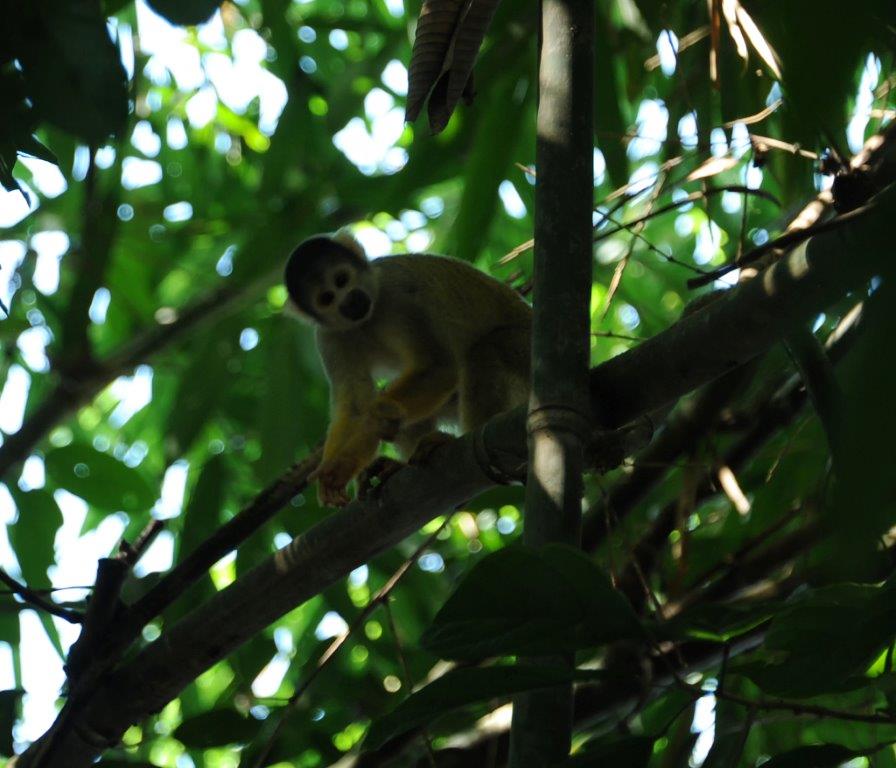
During Our Stay We Viewed Five of Six Species of Monkeys That Live Here, Four of Them At The Tambopata Research Center
At noon we boarded the long boat to go deeper into the jungle and stay the next two nights at the Tambopata Research Center . Our daughter thought it was important to go further into the jungle to and get away from the last outposts of civilization in this area. This river ride took three and half hours. During the ride we spotted many birds, a few caiman and many capibara's. Capibara's are the largest of the rodent family with the beaver the next size down. To us the long ride was part of the adventure going against the rapids in many areas while avoiding bottoming out in shallow water. Arriving at Tambopota Research Center required us to remove our hiking boots at the entrance. This was nice because we liked walking around in our socks on the clean wooden floors and helped us feel very much at home. Lodging was simpler at here. Each of the 18 rooms had curtains for doors and guests had to share the four men's and four woman's bathrooms. Electricity and internet was available four hours in the evening shutting off at 9:30 as well as about an hour in the morning. The food here had the same menu as the lodge and was very good.
After dropping our bags in our room our guide took us on a 3 mile (5KM) hike through the jungle. Taking this walk had us realize that coming to research center was the right thing to do. When we were in the lodge we saw only one species of monkey. Here in this more remote area we encountered two more species just on this hike around. During our stay we viewed five of the six species that live in the jungle in these parts. Fernando told us that the more people encroach the jungle and remove resources the deeper the monkeys go which is why the lodge only had one type. We ended our jungle walk on a bluff over the river with the sun setting and moon rising.
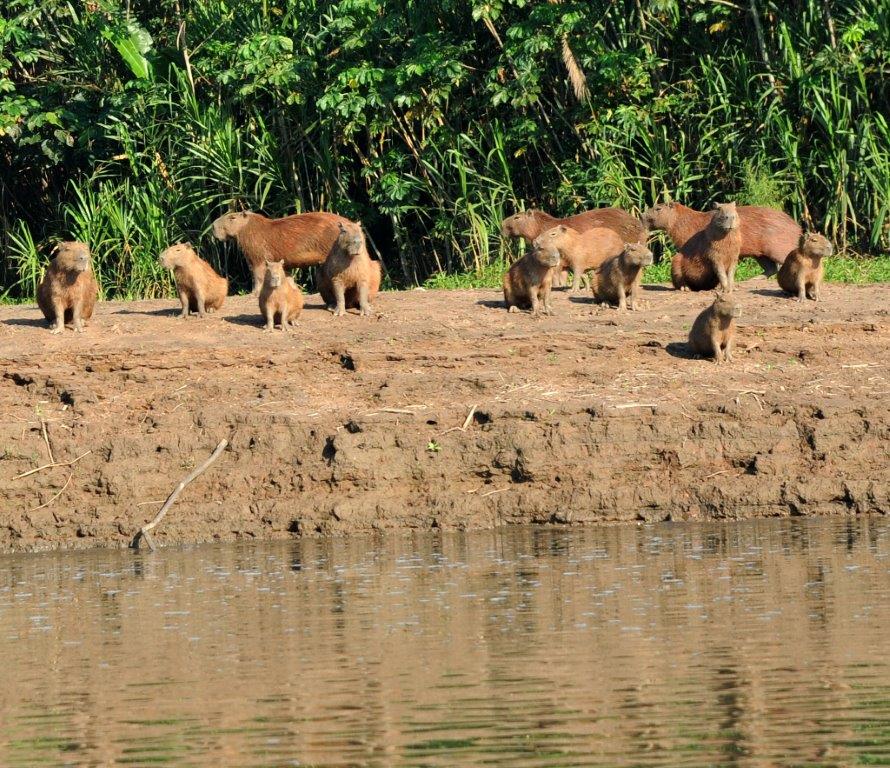


Left To Right: Family of Capibara's on River Bank, Research Center Dinning Area and Rustic Lodge
Tambopota Research Center is a for profit research place. Researchers pay their
own way but guests like us help pay for things like internet, electricity on
expanded hours along with a few other perks like good food that they use. The
research that started here was on the macaw. The macaw is large beautiful bird
that resembles a parrot in many ways but larger. Research started here because
these beautiful birds congregate each morning at a clay lick just a five minute
boat ride up river. After dinner we were given a lecture on the macaws and
the importance that this research center plays a role in their study. We
learned that there are many species of macaws. Most are either listed as
endangered, threatened or watched. Some have been classified as extinct with
another one believed to be extinct. To help the macaws the center took on a
program to remove the "third and fourth" egg of a mating pair. The reason for
this is because anything after two hatchlings are starved by their parents.
Taking the spare eggs helps increase population. They found that 32 human
raised babies did well with some forming nests with wild birds. At the lecture
we were also advised that we were to leave 6:30AM the next day to visit the
clay lick where macaws get certain nutrients needed. To learn more information
on the work regarding the macaws go to http://macawproject.org/

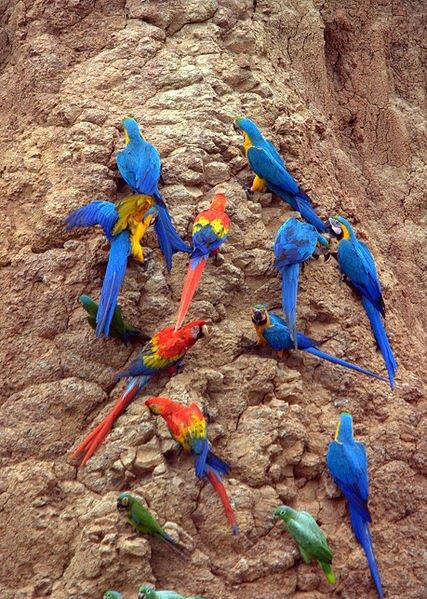

Left To Right: Circling Clay Lick, Landing and Eating Clay, Melissa Viewing With Fernando Looking On (center photo from Macaw Project)
At 6:30AM we boarded the long boat for the short ride up river followed by a quick walk to the viewing area. After sitting on our folding stools for about ten minutes we heard the macaws cackling overhead and then saw different colored birds flying over the clay lick to make sure it was safe to land. Using the guides scope we saw the macaws landing and swallowing the clay. From the sky we saw a beautiful red Macaw dive down and get closer to our group by perching on a branch above us. Within seconds of seeing this beautiful red bird it had surprised one of the guests by landing on her shoulder. From there it hopped amongst different people (including me) before getting comfortable with a family of five. A few times the guides coaxed it to their shoulder to walk down the trail and get it fly away. Each time the bird flew back to the group.. This bird was banded and it was more than obvious that it was comfortable among people. We were also told it is quite uncommon for a bird to visit as it did. After 90 minutes we started to watch pairs of birds fly away so we headed back to the lodge for breakfast. At breakfast we heard and saw several different macaws from the branches nearby. What we did not realize is that they swoop down when the tables are empty to steal the scraps. I saw a macaw grab a roll and bring it to a ledge on our room to share with its mate. When another macaw flew near them to check out the food they both made a loud screech opening up their beaks making the flying visitor very unwanted. Another macaw landed on a perch between the rooms and tables eyeing a guest with an apple passing by. It seemed the guest could not help but give up the fruit to the bird who ate it while some of the guests just watched or took photos. During a nap I was trying to take after breakfast a pretty red bird landed on my table in the room and just watched me. I just turned over and fell asleep.
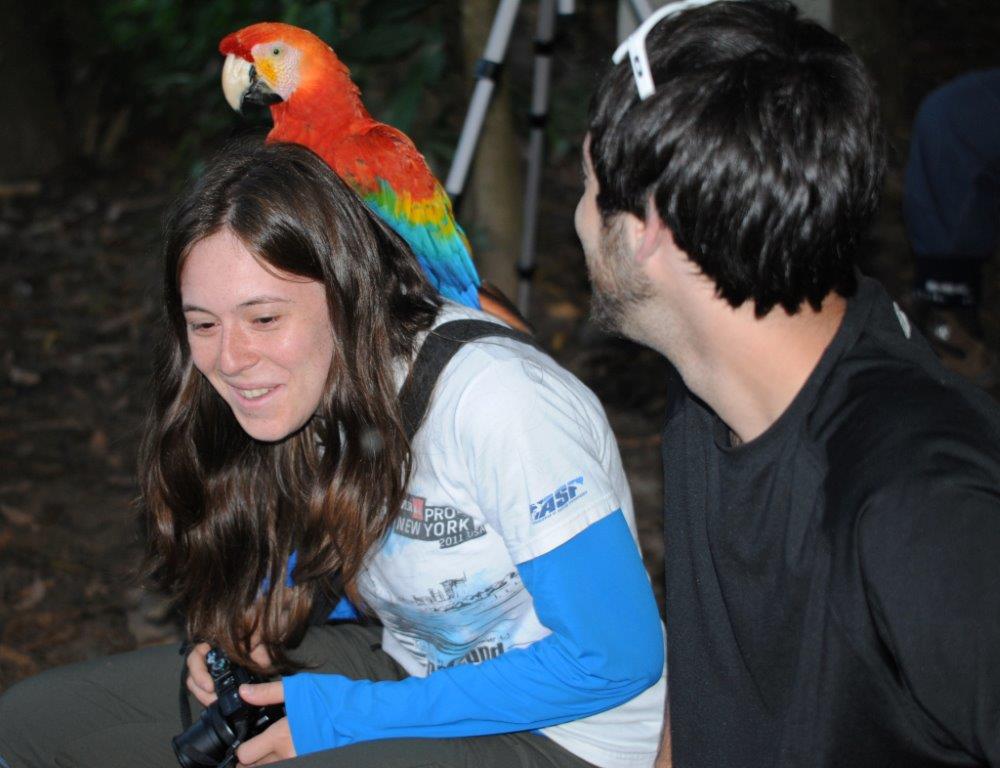
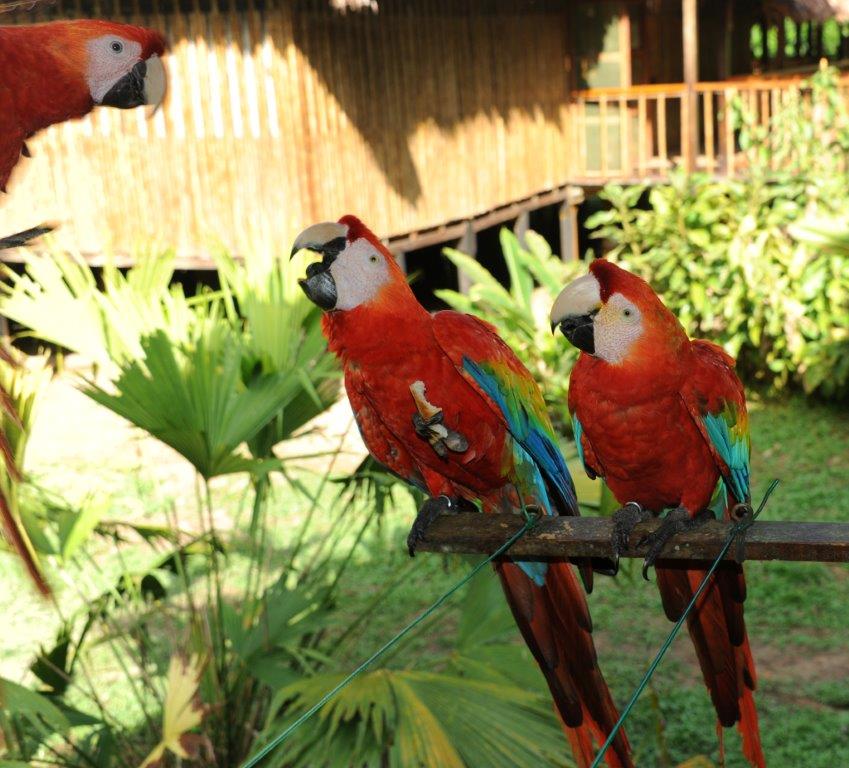
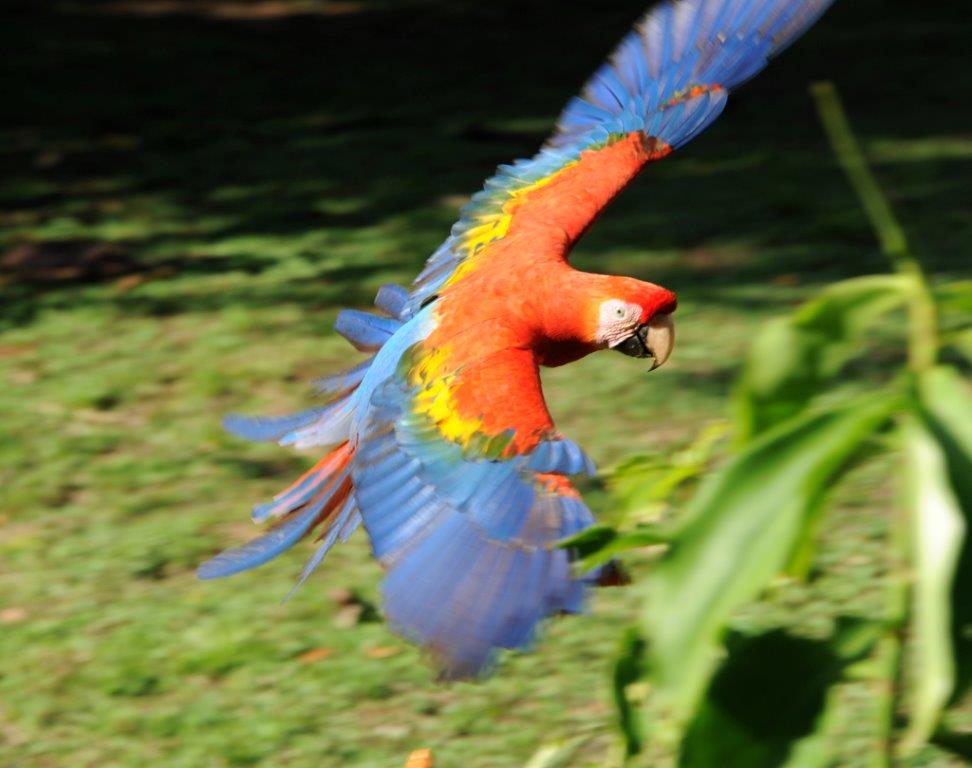
Left To Right: Wild But Friendly Macaw Landing on Melissa at Clay Lick and Macaws at Lodge Outside Our Room
After breakfast and a nap we followed our guide on one of the several connecting trails for another three mile (5KM) walk in the jungle. This time we encountered another species of monkey as well as more birds and colony of army ants crossing the trail. Here Fernando advised us not to linger and step over them quickly. It seems he really hates army ants because they literally eat anything and anyone in their way before moving on. He told us of homes that would be inundated with army ants by the millions. He knew of farmers that were powerless to stop them and would move out of the home for a short time until the ants left. He said the advantage to the farmer would be that there would be nothing left that was edible or alive in the house when they came back. That meant no termites, cockroaches or animals living under the home or in the thatched roof. We returned to a different set of paths at 4PM when the heat was a little less intense. Here we saw the painful flesh tearing bullet ant. We also spent time viewing a father monkey with its two month old baby clinging on its back just a few feet over the trail and on a branch. We nearly missed it because it was so close to us. The jungle walks we did during our stay were easy and interesting. While we were clearly hot and perspiring due to the high humidity, we looked at the bright side of things as we were not roasting under the sun due to all the tree cover. After dinner we did a one hour night hike. Here we spotted stick bugs hiding in the bushes and trees, a couple of tree frogs less than two inches long, different spiders and heard rustling in the trees. We were not able to see more animals as it was a full moon and the animals tend to spot us easier and move away.
At 7:15AM we left the Tambopato Research Center to head down river back to the Refugio Amazonas. Our first stop was to meet up with someone at El Gato Creek for fishing. On arrival we walked 15 minutes to the creek to use native sticks and strings to catch dog fish and piranhas for an hour and then head to the rapids between the rocks to catch a fish that has some of the longest teeth I have ever seen. Upon getting to the creek our fishing guide collected some pods about three inches long and chopped them. He showed us the white one inch grubs that grow in them. He said they are used for bait or to help people with asthma when they are eaten by them. He said they are good for you and chewed a live one. Melissa took the challenge and ate the second one out of the pod. Daniel joined in and ate his still moving. (The kids did not have asthma that evening and were not sick from eating the live grubs bugs.) We also used some sliced meat as bait. Unfortunately we did not catch anything in the creek other than a three inch fish Melissa hooked. Our guide said it was a little late in the morning piranhas to feed. With that said we headed up river to the rapids. Here we used spin caster with two rods baited with cut up pacus (A relative of the piranha) and the other one with a yellow lure. Daniel ten minutes into fishing had a large thrashing on his line where I saw a two foot long fish attack the bait in such a way that it cut the line just above the metal wire used to protect the hook. About thirty minutes later using the lure I hooked an eight pound (four kilogram) payara and brought him in. The fishing guide seemed pleased as he told us that earlier in the day eight Argentinean men were fishing the same rocks and in three hours and only caught one fish. With the day at its hottest point and feeling the fatigue of it we went down river 20 minutes to lodge for lunch and a rest.
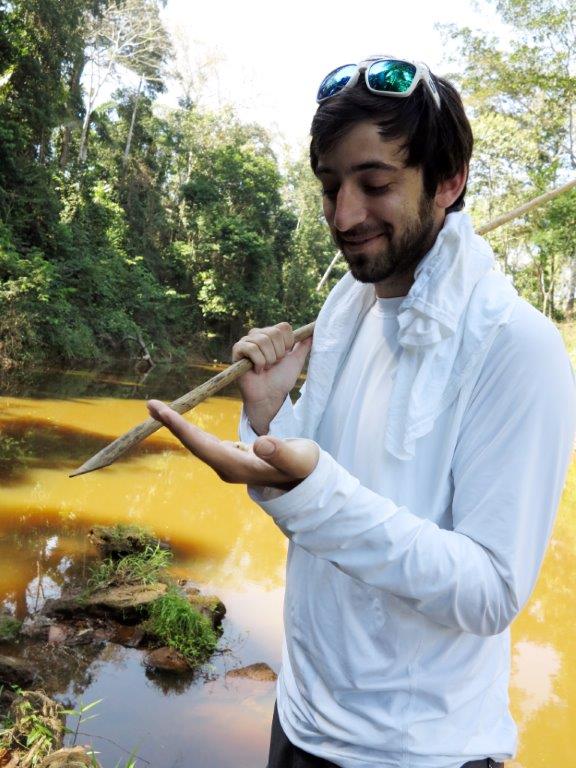
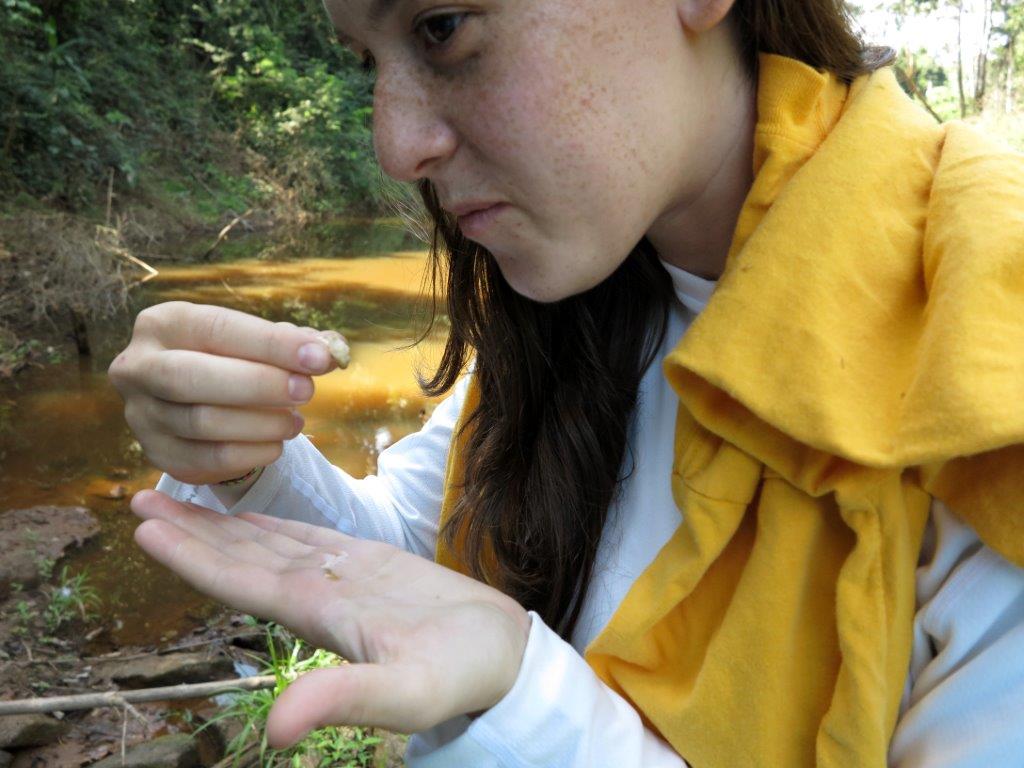

Kids Snacking On Live Grubs At Piranha Fishing Creek I Caught an 8 Pound Sharp Toothed payara
For the last afternoon's activity we post posted our 3:30 walk until 4PM. This was a good idea as the temperature seemed better just 30 minutes later with the sun a little lower. Our 90 minute walk had us access a few different the trails in the area. On the way we enjoyed being under the canopy and seeing and hearing some of the creatures that live in it. We ended our walk above a clay lick and viewed wild boars from 150 feet consuming clay. These creatures omit a pungent odor so we did not linger too long. Before dinner the kids requested I help chase away a friendly six inch possum from their room. This animal was not a threat to them but they did not want it sitting in the corner so with the help of two hand fans I helped nudge the curious creature away.
Bedtime in the jungle comes pretty early for everyone due to early rising as well as the power cut off by 10PM. Tonight was no different however about an hour after falling asleep I was awoken to Maureen who heard a light thud and looked at her night stand to find a cute four inch frog. She was a bit alarmed and demanded me to remove it. With that said and realizing that the frog was not going to jump in the bed due to the netting I reluctantly in a sleepy daze grabbed my camera for a photo opp before giving the friendly visitor a nudge seeing it about four feet to a rope and climbing it fiercely as I chased it away. Falling back a sleep to pleasant sounds of the jungle was quite easy.
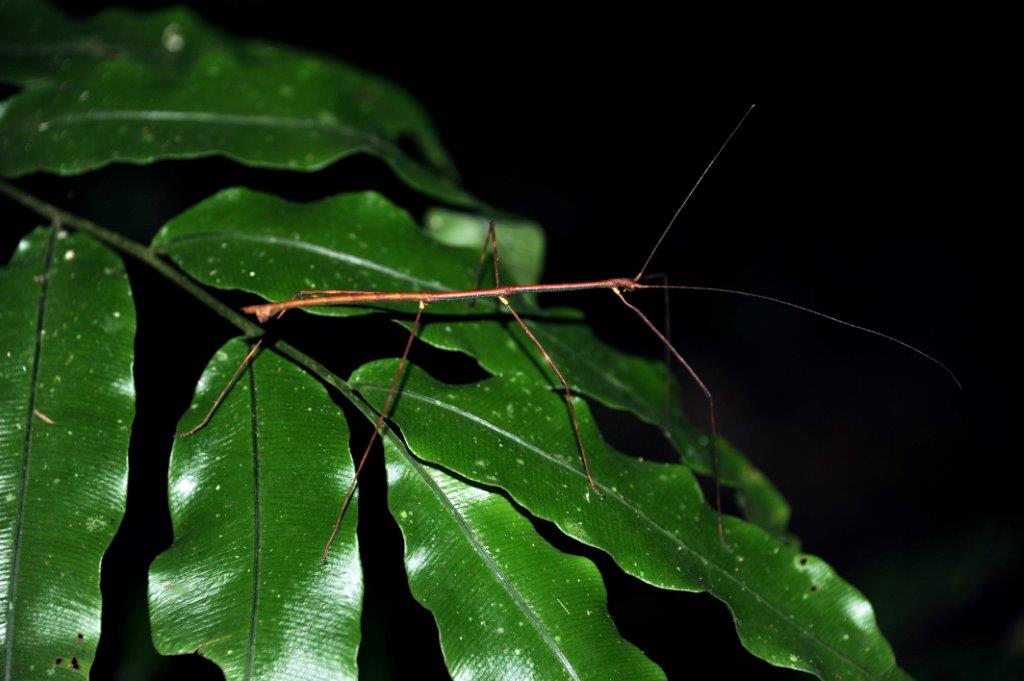

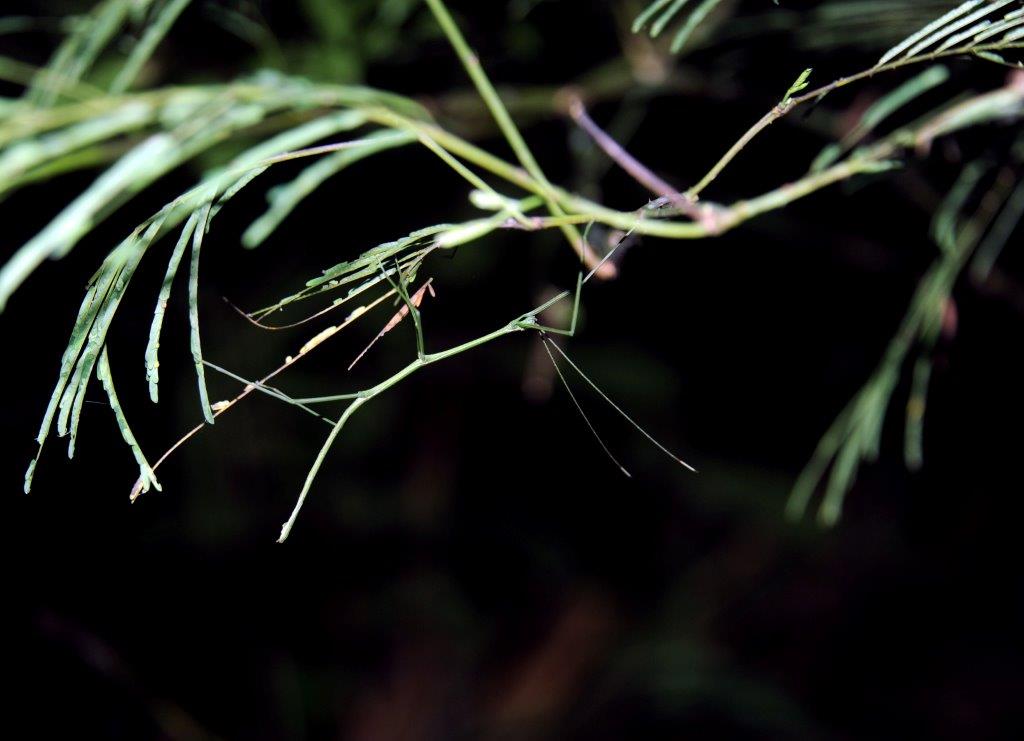
Found Ten Minutes From Lodge With A Good Flashlight and Patiently Scanning The Trees A Brown Stick Bug, Tree Frog and Green Stick Bug
At 7:30 we boarded the long boat for the two and half hour ride back to the office with the current with us on the river. We enjoyed this last ride as the artificial breeze from the speed of the boat felt perfect. We reflected on our visit to the Refugio Amazonas and Tambopata Research Center and thought the combination of doing both was a good idea. We also decided another day would have been a good idea so that we could have had some time to kayak part of the river. The rest of our day was spent getting to Lima and then taking the four hour drive south to Paracas on the coast for the next leg of our Peru trip.
Chapter Three: Desert Fun, Nazca Lines Flyover And Lima
Paracas is a small beach community with a few good hotels and a small downtown street lined with tourist shops and restaurants. Our hotel, La Hacienda, had a beautiful pool overlooking the bay. We could not take advantage of the pool or the kayaks due to the cool breezy weather of the winter season that we appreciated. Today we planned one activity and left the rest to lounge about for some needed down time. This region has large sand dunes so we picked a wild ride in a six passenger dune buggy with a stop for sand boarding on the dunes. After being strapped in our driver took off in this open vehicle having the protection of a full roll cage. He went up and down and around the dunes giving us a feel of being on a mild roller coaster. While we probably never topped 40 miles per hour, it felt faster with the wind (and some sand) in our hair. Sand was not a problem for our eyes as goggles were provided. During our ride our driver went up a steep dune only to startle us by going down at a better than 60 degree angle or what looked like a fairly large drop. We were never afraid of flipping over at anytime as our driver was very experienced and knew how to read the dunes.
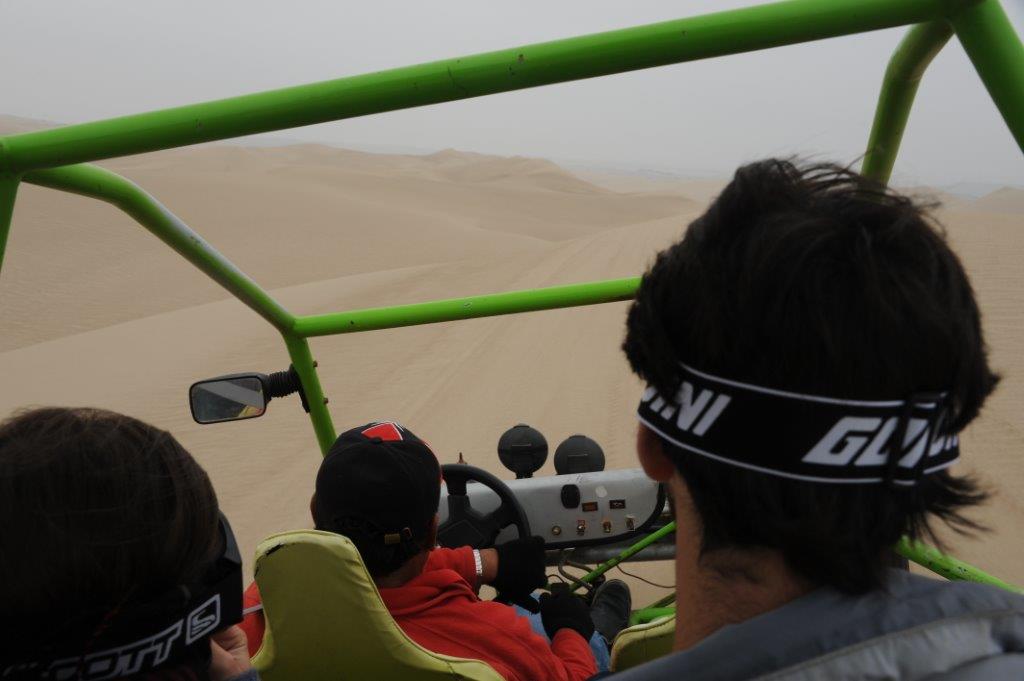
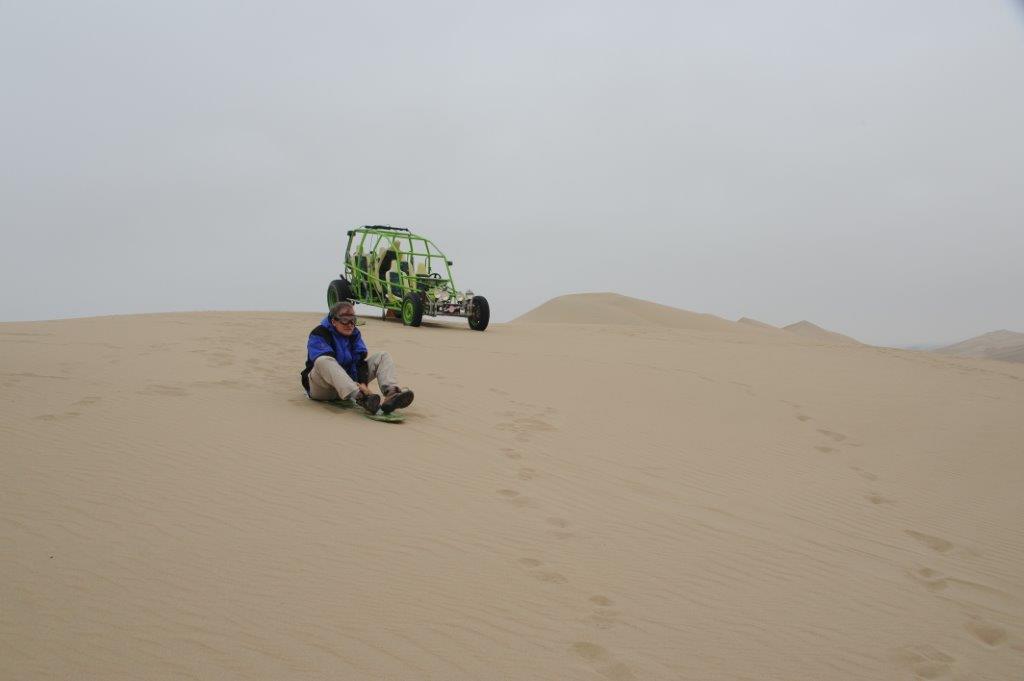

Five Passenger Wild Buggy Ride. While The Parents Chose To Sit On My Board, Daniel and Melissa Stood
Halfway into the ride he stopped and pulled off four sand boards attached to the top of roll bars. He then waxed them and showed the kids how to stand on them, speed up or slow down if needed. He advised than that turns were not possible as in snowboarding and then gave them a gentle push down the hill. For us parents who were not into standing he showed us how to sit and control the speed if we wished. He then told Maureen and I to sit and hold on the center strap as he gave us a push down the hill. This was a lot of fun. We then walked up the hill for another run before being picked up on the bottom by the buggy and taken to another hill for a longer run and faster run. With the hill too steep to climb in the sand he drove down to pick us up. From there it was back to the garage with all of us wearing big smiles. Lunch was at the Delfin Dorado on the strip at the beach in town for some tasty fresh seafood followed by strolling the stores after. On our return we explored the beach in front of the hotel. Unfortunately it was low tide and we realized that this was not a good place to swim even if the weather was warm. What we saw on the beach were some of the largest and prettiest beached jelly fish. Some were 18 inches across. From there we spent the rest of the afternoon at our rooms reading or catching up on email on the balcony overlooking the bay. The La Hacienda of Paracas is a nice resort with one of the better pools I have seen that should be visited in the area during the summer.
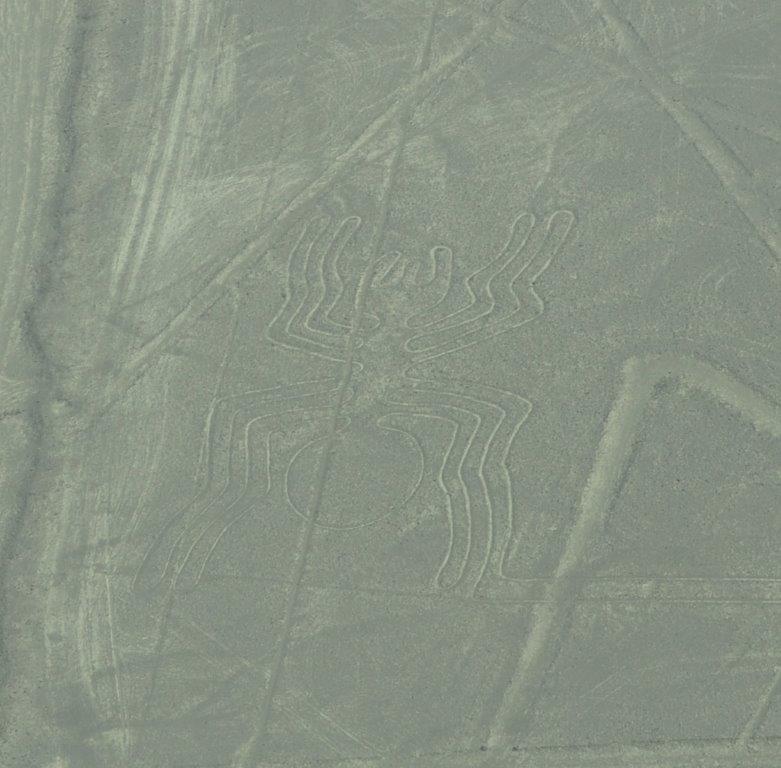
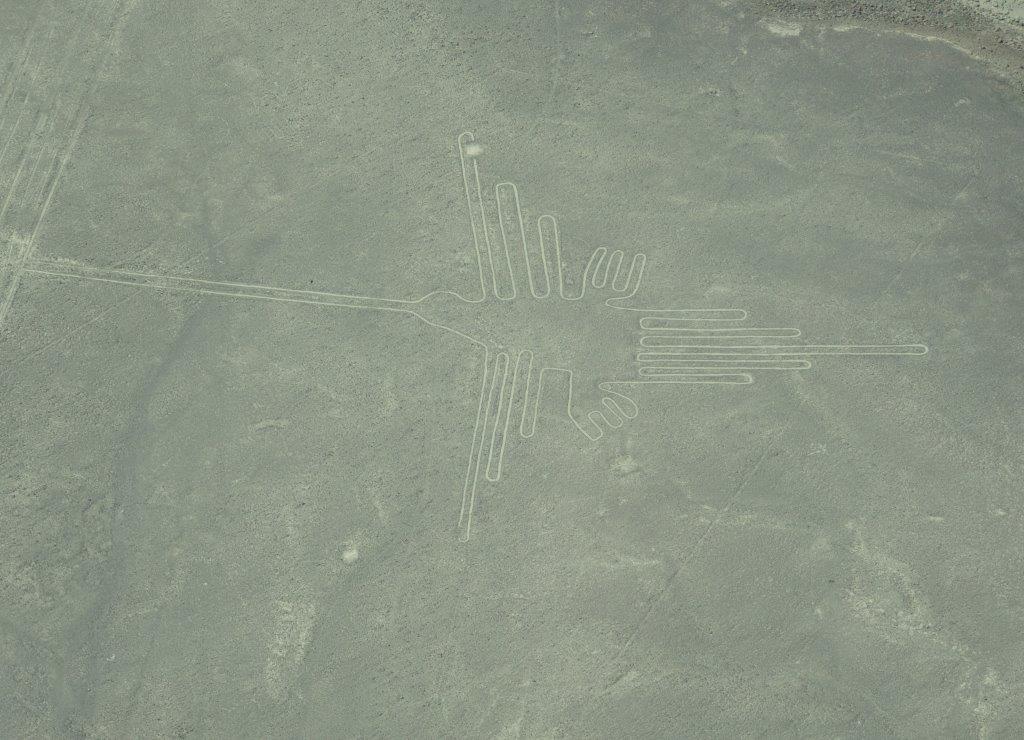
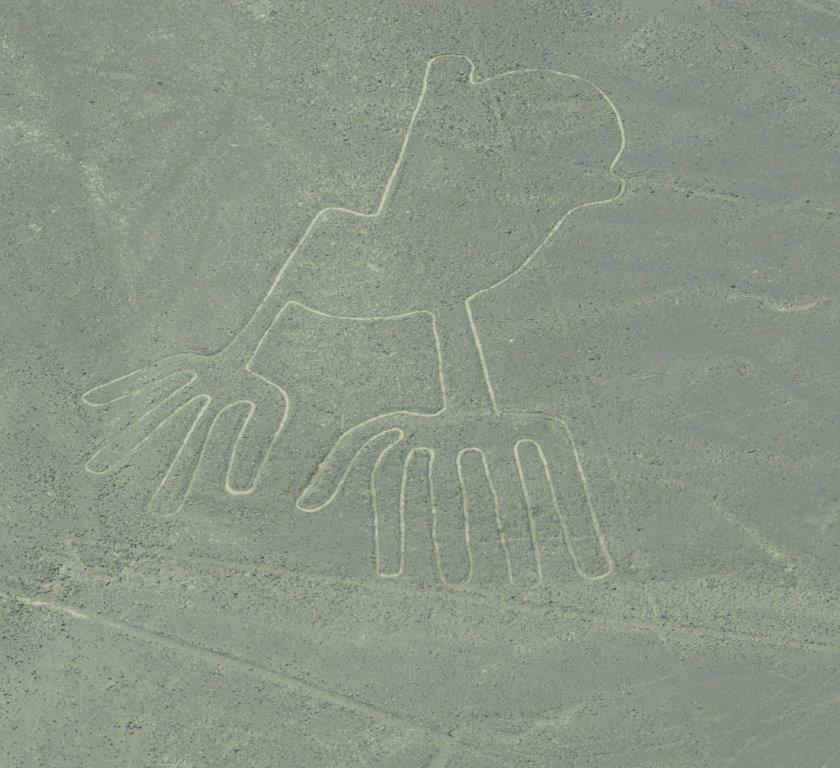
I Had To Slightly Enhance My Photos To Make The Figures Easier To See. Left to Right, Spider, Chicken, Hummingbird
The next day we were shuttled to the Pisco airport to take our fly over of the Nazca lines. The Nazca people were believed to have created these large drawings of animals, shapes and even a human looking figure between 500 BC and 500 AD. The drawings were done by digging a four to six inch deep trench and removing the red or brown colored rocks and pebbles. This exposed the lime base underneath. The drawings have survived due to this part of the world having one of driest deserts on earth. It also does not see a lot of wind here so the ground does not change much. Our flight took 35 minutes to reach the area where we would view about a dozen or so figures. The ride over was pretty smooth at 7500 feet. Once we got close the plane lowered to 2500 feet and became uncomfortable for some of the passengers. To see the drawings the copilot narrates and explains which side of the plane they will be on. At that point the plane banks sharply and turns for viewing. The pilot than makes a figure eight banking on the opposite wing so the other side can see the shapes in the ground. Doing this about a dozen times is not easy for people not used to small planes. Some of the figures were harder to make out that others. Our favorites were the monkey, hummingbird and spider. After seeing a dozen figures the pilot increased altitude to 7500 feet for the smooth ride back to Pisco. Unfortunately when we landed our kids were out of sorts and did not care to go on to the oasis town of Ico and then do more sand boarding so we drove to Lima for the last leg of our trip. If you don't like small plane rides that make tight turns do not do this ride..
Lima
We arrived in Lima in the Miraflores section of the city which is typically where tourists stay. We rested up an hour or so before walking to Panchita for dinner. We picked this upscale place because it served guinea pig on the menu along with other Peruvian food we were interested in trying. Panchita should not be missed. It is a modern style restaurant with emphasis on good flavors, large portions and sharing. When seated you don't have to order bottles of water as theirs is filtered. We were also given two types of freshly baked breads with several dipping sauces. Our group started with an order of their special sauced wings as a first course followed by the guinea pig, a sampling of eight Peruvian stews and half portion of strip steak that weighed a pound. Before we knew it we had a table full of delicious food. The guinea pig came fried and quartered. The skin was crispy with the meat tasting a little like the dark meat on a chicken. I recommend sharing the guinea pig because to me it is a little greasy to have for one person. The eight stews came in an ample size portions in cast iron bowls for our group to share. The flavors and ingredients of the stews were diverse and worth trying. The South American cut steak was cooked to order and was the only thing "average" on the table. Three main courses, avocado tomato salad and the wings were more than enough food for our group of four costing about $100 which would be a bargain compared to prices at home. We would not hesitate to come back here again when in Lima. Afterwards we strolled several blocks and watched people having a good time and going about their business on this Saturday night before calling it a night for ourselves.
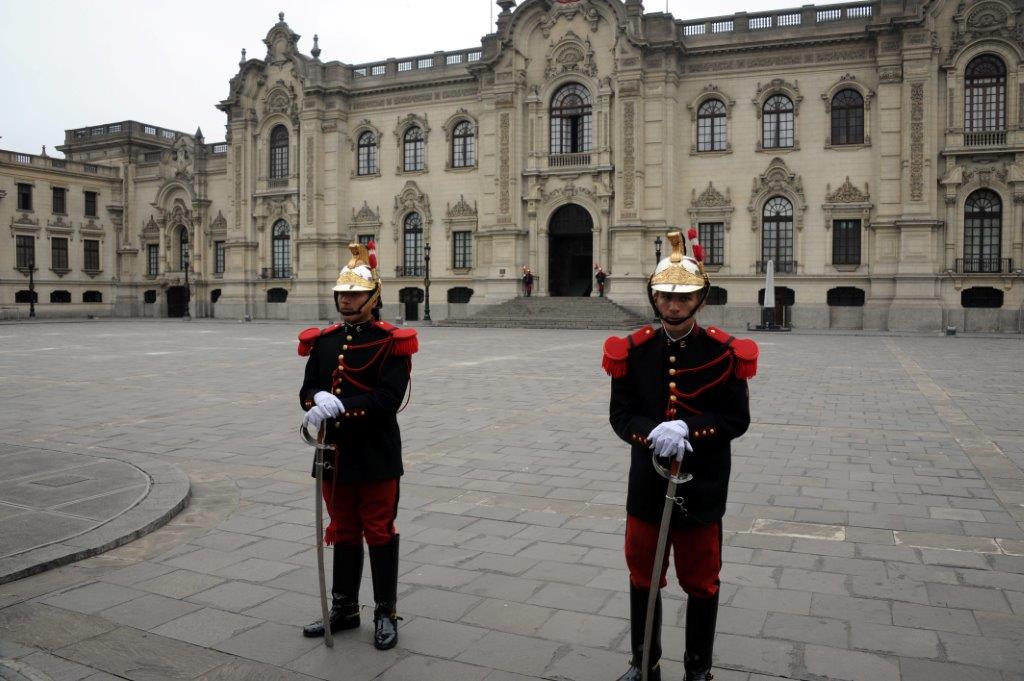

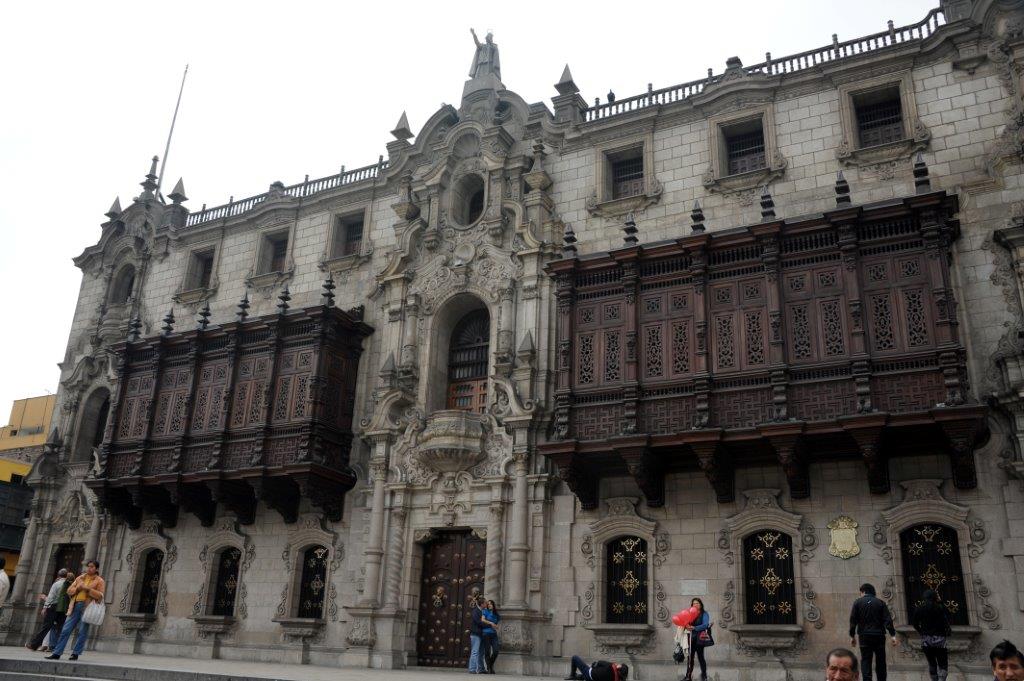
Lima: Left to Right: Palace, Crypt With Bones Below, Old Spanish Building With Classic Balconies
Sunday was our last day in Peru. We were picked up for our three hour tour of the city. Our tour started with the park overlooking the waves and surfers on the Pacific Ocean in Miraflores and then continuing through a few districts of Lima. During our drive we saw many old old Spanish colonial homes and structures. We stopped at one church and one basilica where we took the underground crypt tour. We also walked a few streets until we got to the old Federal Reserve Back which is now a small anthropology museum where we saw artifacts dating back 3000 years. Afterwards we requested to pick up some empanadas and sandwiches at a local taberna and be dropped off at the Rafael Larco Herrara Museum. The reason we wanted to end our tour here was to see and understand a little more about Peru's past. This private museum has one of the largest collections of pre-Inca artifacts including what may be the oldest and most detailed "erotic" pottery in the world. What I learned on this trip and at this museum is that the Inca rule was pretty short lived compared to other past cultures there. I am sure their rein would have been much longer if not for the Spanish conquest. What we did see were artifacts and history of what was a dozen or so different civilizations before them. Many of these ruled Peru much longer than the Inca's. After our visit the museum ordered us a taxi to be taken to the Inca market in Miraflores for last minute shopping at the many stalls there. Dinner was just off Kennedy Park and then it was off for our midnight flight to the home.
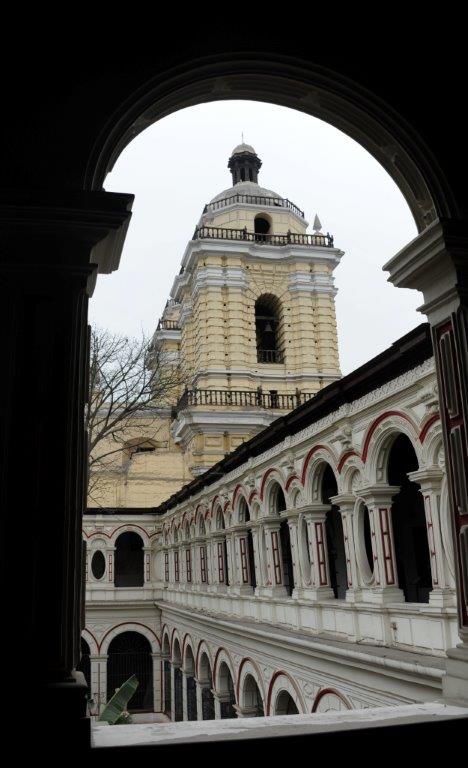
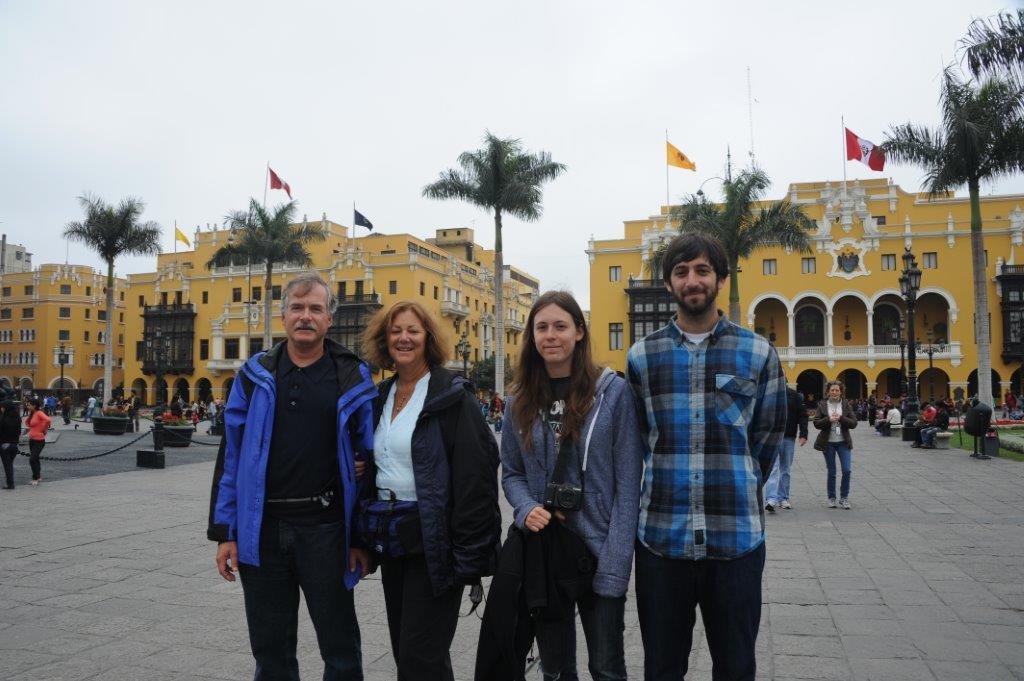
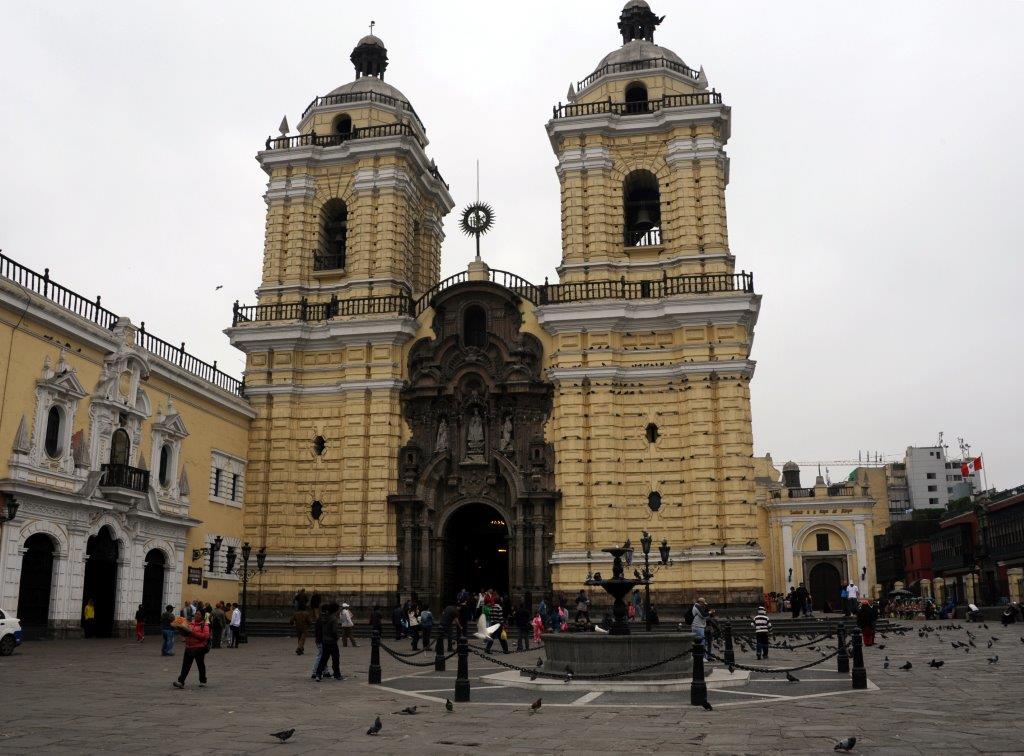
We enjoyed our visit to Peru. We came to appreciate a country that has many things to offer visitors. We liked the food, the Incan sites, the Amazonian Basin and the people we came across and would not hesitate to recommend a visit here. If you would like to book a similar trip customized to your taste please email me at tab@tabhauser.com
(some food shots of Peruvian Stews, Guinea Pig, Fish and Fresh Scallops on the Shell and tasting the local wine)
Thumbnails of Transportation in Rural Areas
If You Go:
www.tabhauser.com Travel Consultants can help plan your trip to Peru whether you are on your own, wish to have private guide or with take part in a group tour. Contact tab@tabhauser.com
Things To Be Concerned About:
Food and Water:
Peru does not have safe tap water to drink. Do not even brush your teeth with it. The rule here is to be careful not to eat unpeeled fruits or vegetables unless they are washed in purified water. We found most of the places we ate at did this. You may pay a little more for your food, but it is worth it. The few places we ate at that we were concerned about had us skip the salad or anything uncooked we were not sure of. Do bring Cipro and ask your doctor how to use it in case you have a stomach issue. Pepto Bismol something we also do not leave home without. During out trip no one got sick in this way. As for prices, we splurged on some better dining. While our meal at MAP in Cusco or Panchita was considered a little expensive in Peru, for Americans getting that quality of food in the United States would in some cases have cost us double. Our meal at Panchita for four was $100. On Long Island it would have been more than double so enjoy yourself unless you are on a tight budget.
Handicap Accessibility and fitness:
The archaeological places and jungle we visited were not suitable for anyone with a walking impairment. We also recommend you be in at least "average" condition if you plan on walking around Machu Picchu and some of the other sites.
Altitude:
As a precaution we took with us Diamox. This is used for people that are concerned about the effects of altitude. Doing things above 9000 feet should not be taken for granted. Some people get headaches while others can get altitude sickness. The best way to prevent this is to avoid alcohol the day before and during your stay at these heights. Hydration is critical so drink lots of water and move slowly. Also, do not leave without putting sun screen on. Being higher up can make you prone to getting sun burn. Rest anytime you need to when walking around the archaeological parks.
Crime:
We were told crime was not a problem in the places we visited. We were also told hide our wallet so it cannot be pick pocketed easily in busy places. I wear a vertical hidden pouch that attaches to my belt and hides inside my pants on the side to keep anything safe. I keep only a visa card and a small amount of cash in my front pocket when I go about my day. We did not feel threatened at the any of places we visited. Use the same common street smarts traveling abroad as you would at home. Don't take your good jewelry and don't walk by yourself in areas late at night that are not frequented with people.
Touring Around:
If you go totally on your own you should be sure to arrange your train tickets and admission to Machu Picchu in advance. Supposedly there is a 2500 person limit per day for the sight. When we were there every seat on the train was sold. During our visit we noticed you can hire a guide at most entrances. Jungle tours also need to be booked in advance as you need to arrange plane tickets and pickups from the airport.
Bargaining:
We purchased yarn, paintings, alpaca gloves and socks and other trinkets at different stores and stalls. We found that in most cases 30% off the asking price is what we got. Keep in mind you can spend more time than it is worth to win a few more dollars off your deal. Decide if this is worth your time and remember those extra dollar or two on the cheap items means a lot more to them than to you.
Hotels:
Rumi Punku Hotel, Cusco: We liked this hotel a lot. While we found the room a little small, it made up in charm and service. It is located about ten minutes up the hill from the town center. It is basically a three star hotel that has four star service www.rumipunku.com/
Costa del Sol Ramada, Cusco: This hotel is located just a few minutes from the town center. We loved the style of this 300 year old private villa from the outside. We did not like the lack of windows in each of the bedrooms the family suite we had. Also, the old doors have thin wood that needed to be restored. The old tile floors outside the rooms had us hear the clickity - clack of luggage being wheeled too early in the morning. If you want to stay at a old Spanish villa this is your change. www.ramada.com
Sumaq, Aqua Calientes (Machu Picchu): This hotel is one of the best in town and we highly recommend it. What is nice is that it comes with a three course dinner that we enjoyed on each night. Dining here beat walking around the town and being solicited by people with what looked like generic menus as you passed their restaurant. In town nearly all the restaurants looked alike.
www.machupicchuhotels-sumaq.com/
Refugio Amazonas and Tambopata Research Center: See above jungle section
on their descriptions. We recommend going to both locations owned by Rainforest
Expeditions. BE PREPARED HERE. This means taking light weight clothing you can
buy from a outdoor or sporting stores. Clothes should long sleeves and zippered
out long pants. Our long sleeve shirts were the same material you see people
swim in to avoid the sun. You can wear T shirts and shorts at the lodge but not
on the hikes of by the river. Bring good bug repellent. We bought a 40% deet
cream that worked well. The advantage here is that it packs smaller and works
better than sprays where you waste half of it in the air. We also took 100% deet
but hardly used it. The other thing I would say is bring older clothes as there
is little vanity in the jungle. I brought old T shirts to sleep in or wear at
the lodge and donated them with a back up pair with some older water/hiking
shoes I hardly wear at home into a bin for the staff.
www.perunature.com
Casa Andina, Miraflores (Lima): This is a good three and half star hotel
in a good location that caters to tourists. We liked the breakfast selection
that you can order away from the buffet at no extra charge. http://www.casa-andina.com/

Thank you for allowing me to share this with you. Comments can be sent to tab@tabhauser.com
HOME PAGE www.tabhauser.com
.